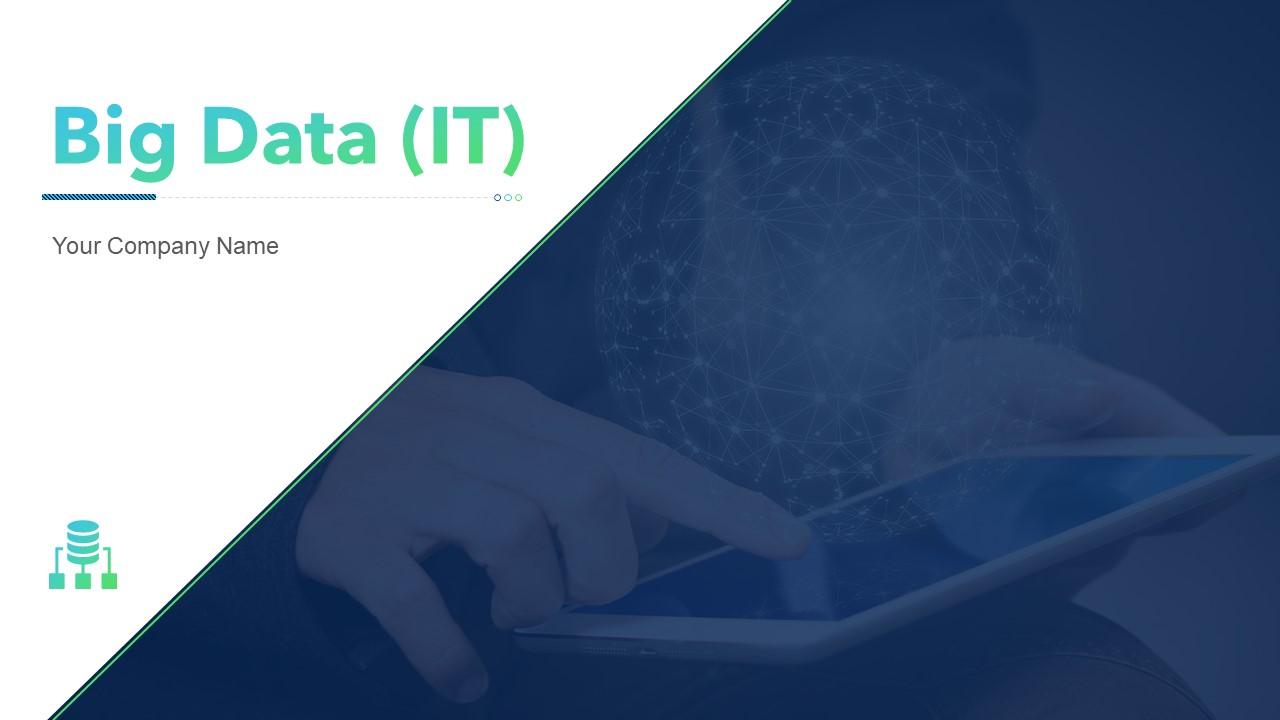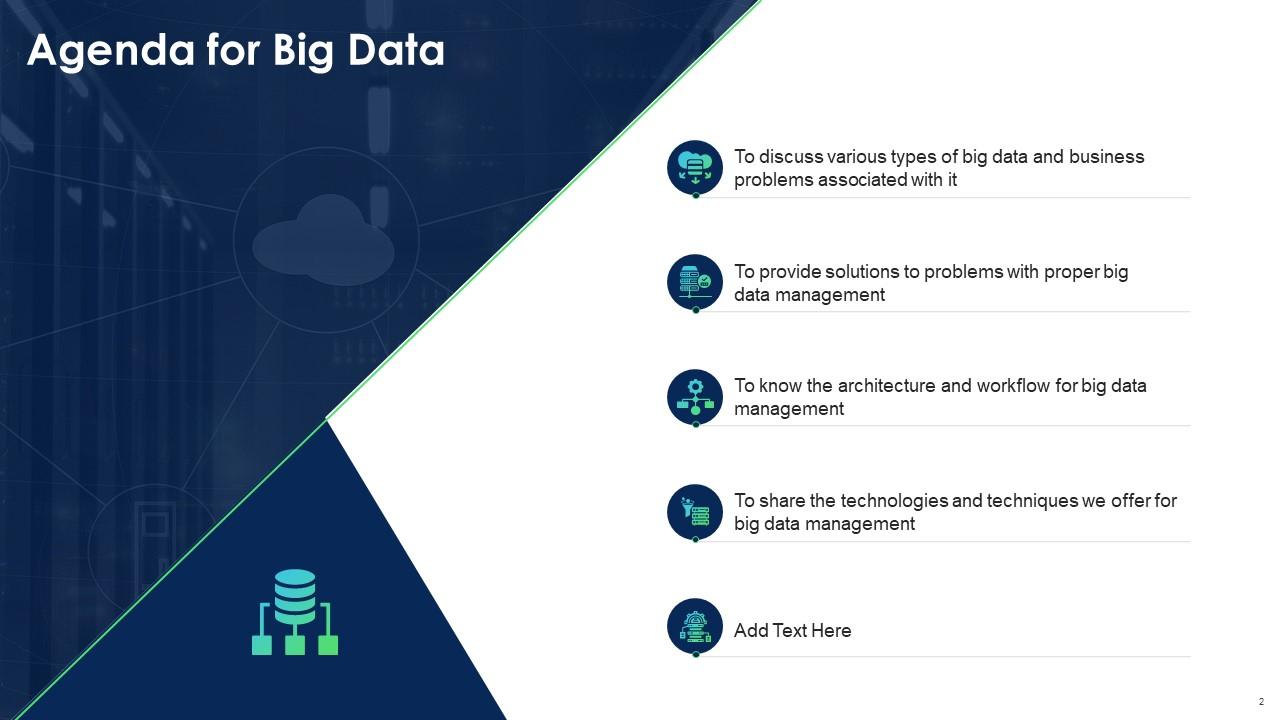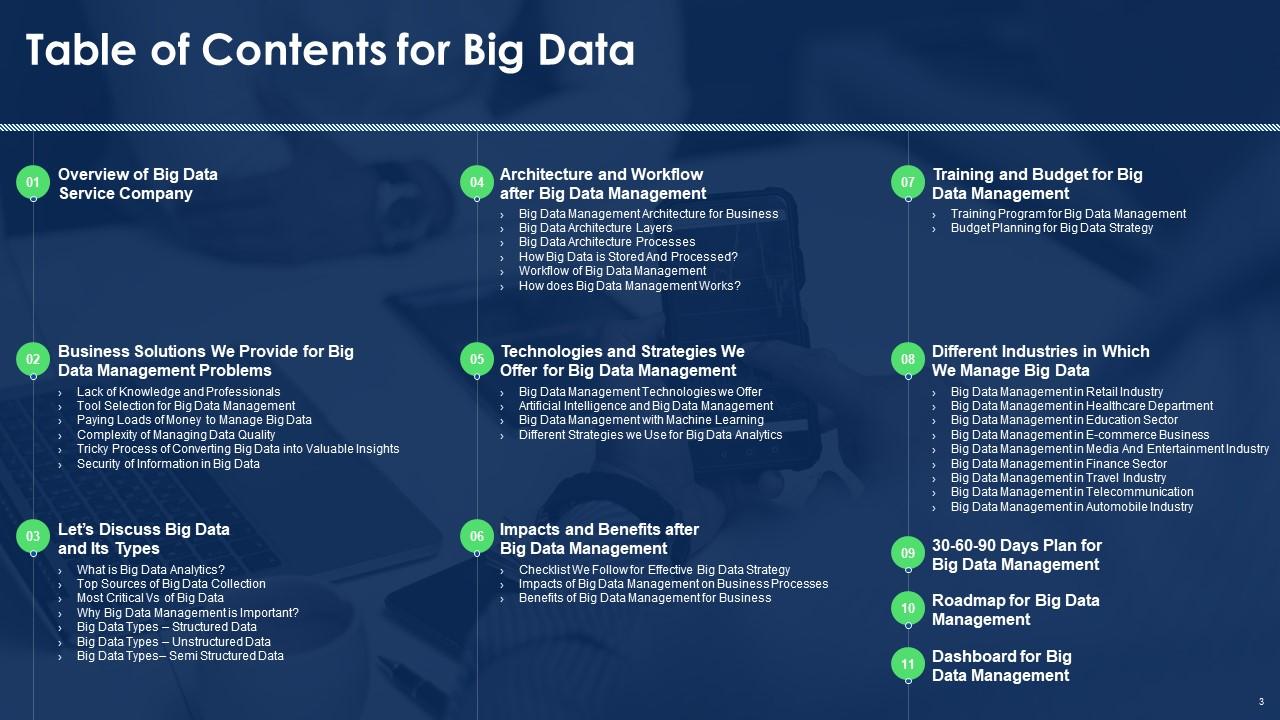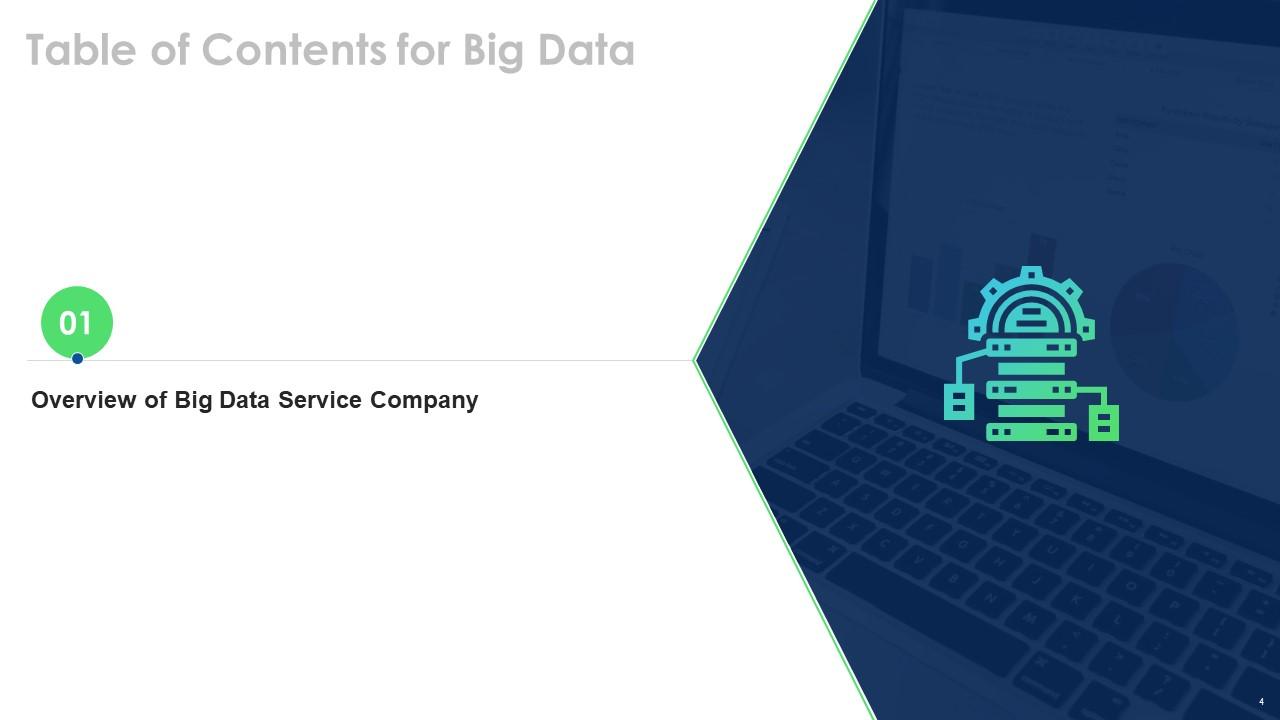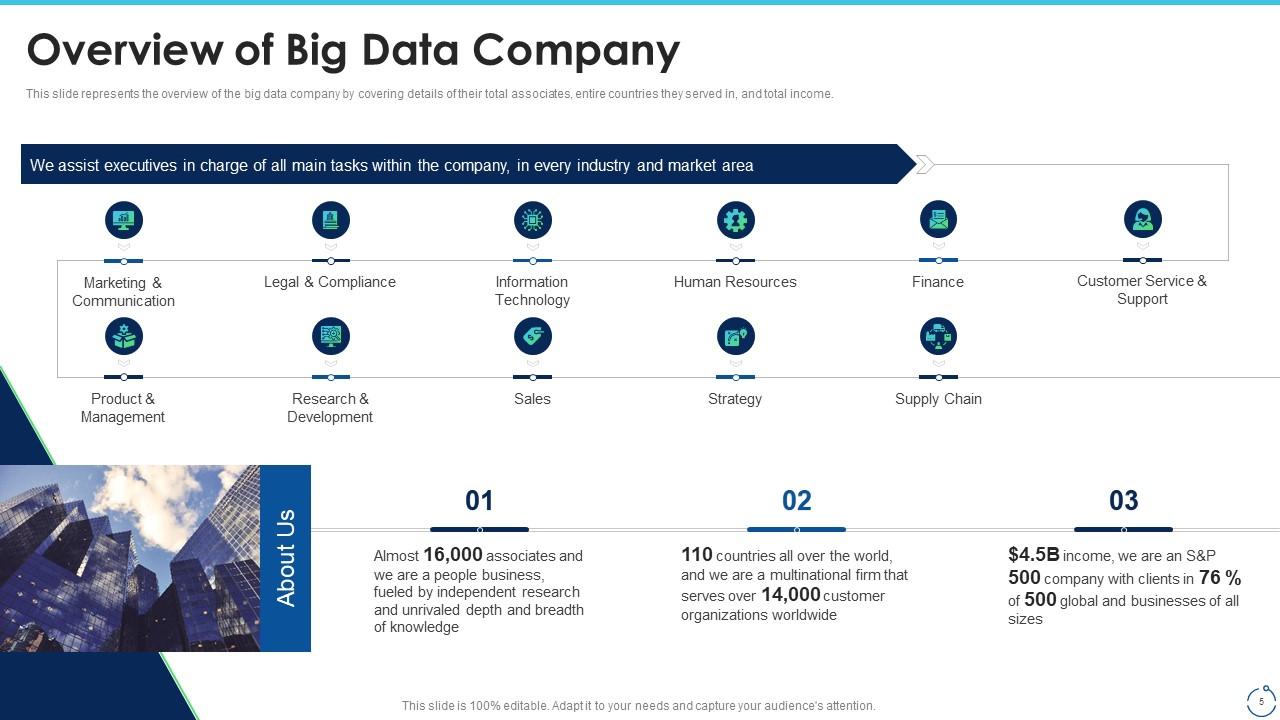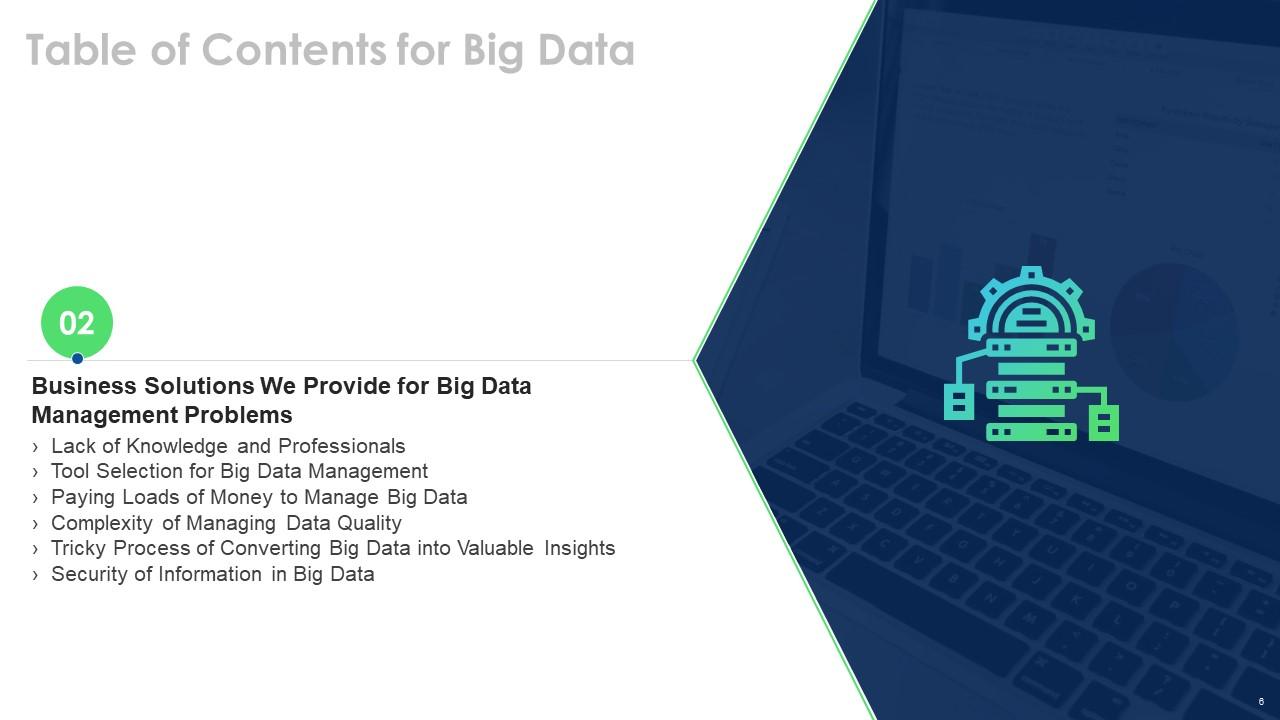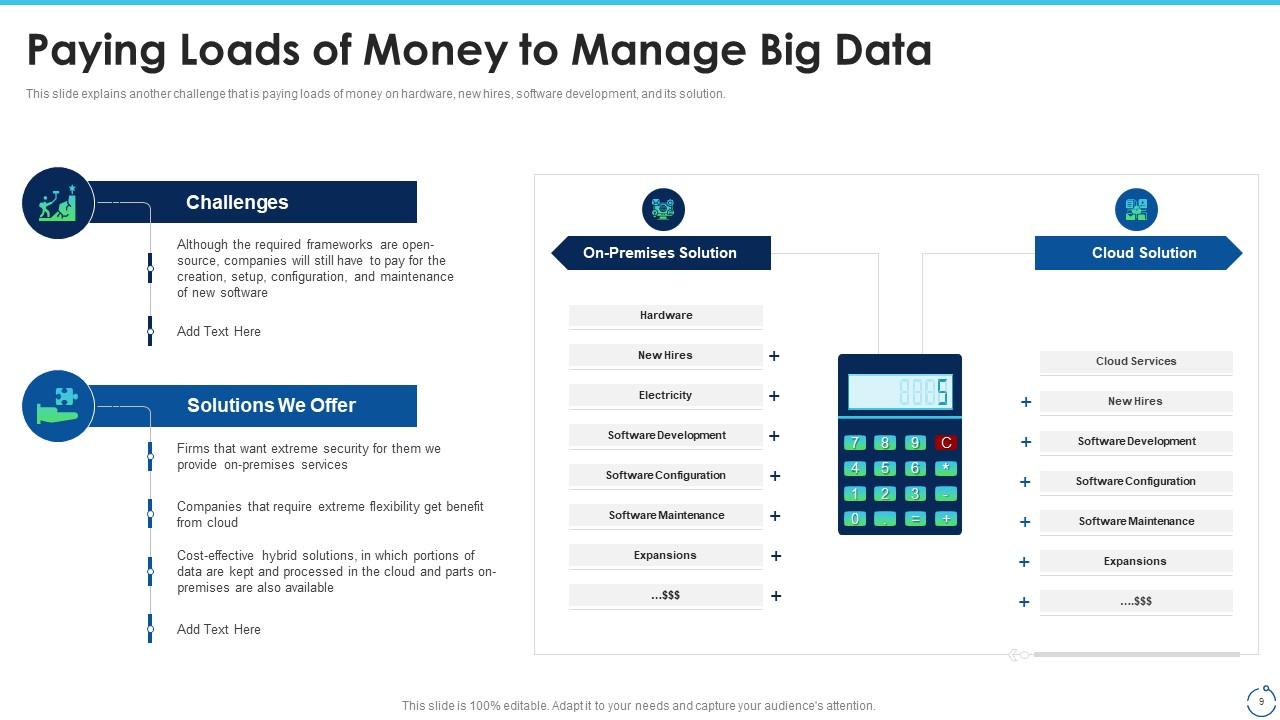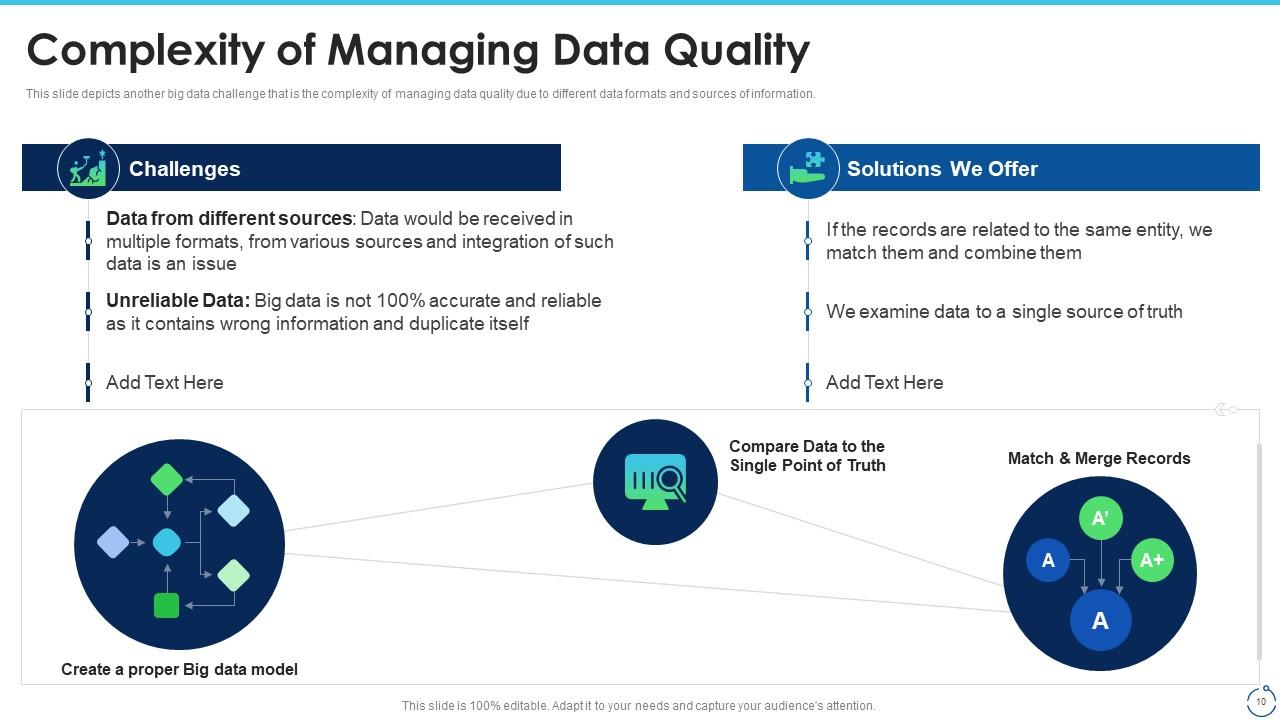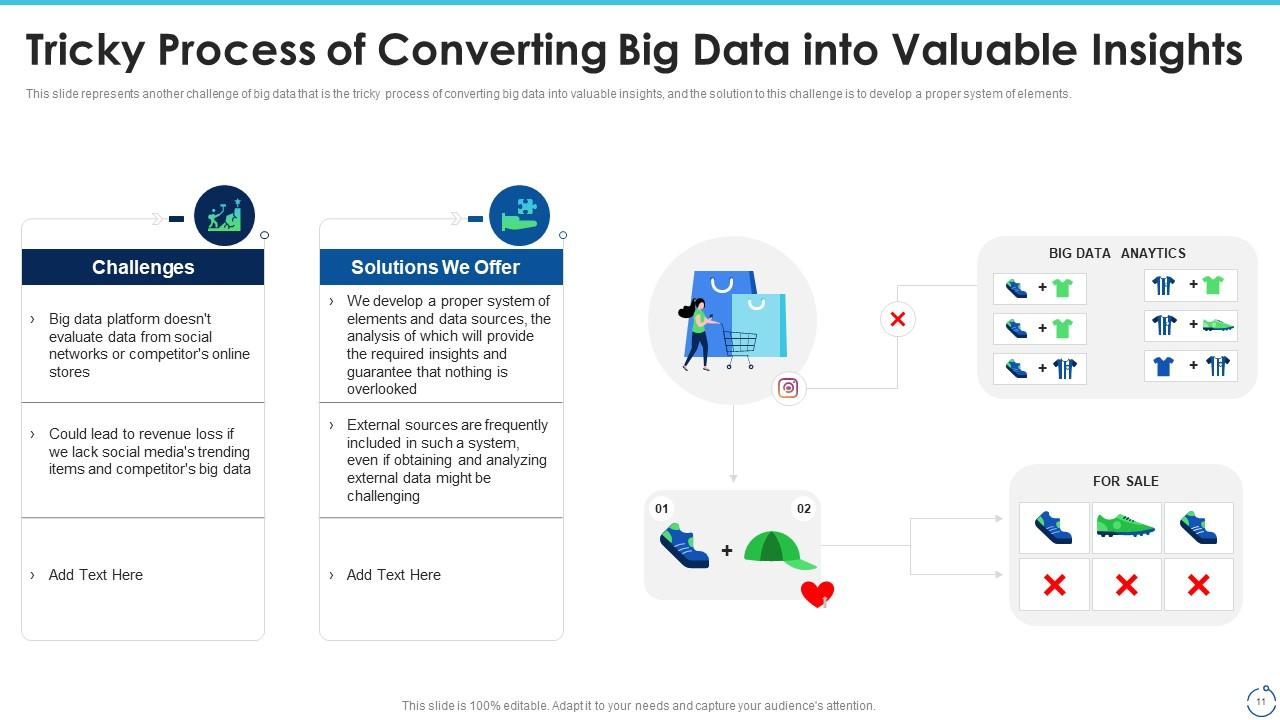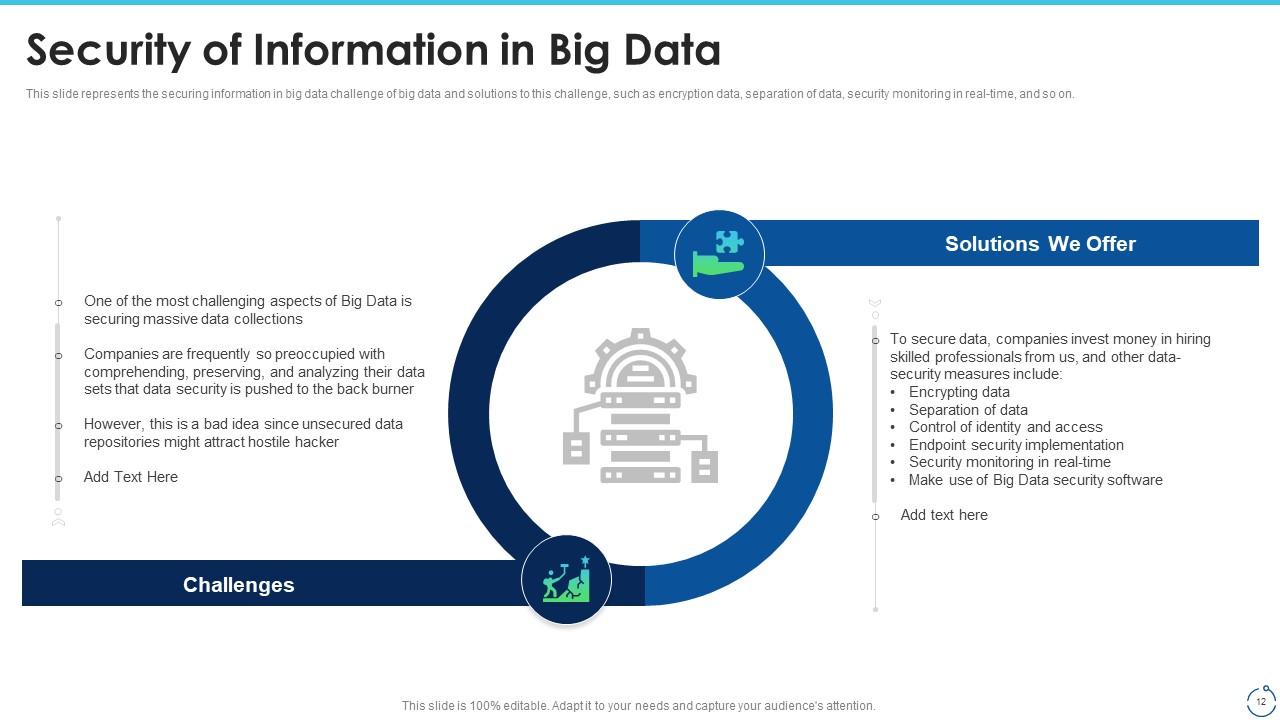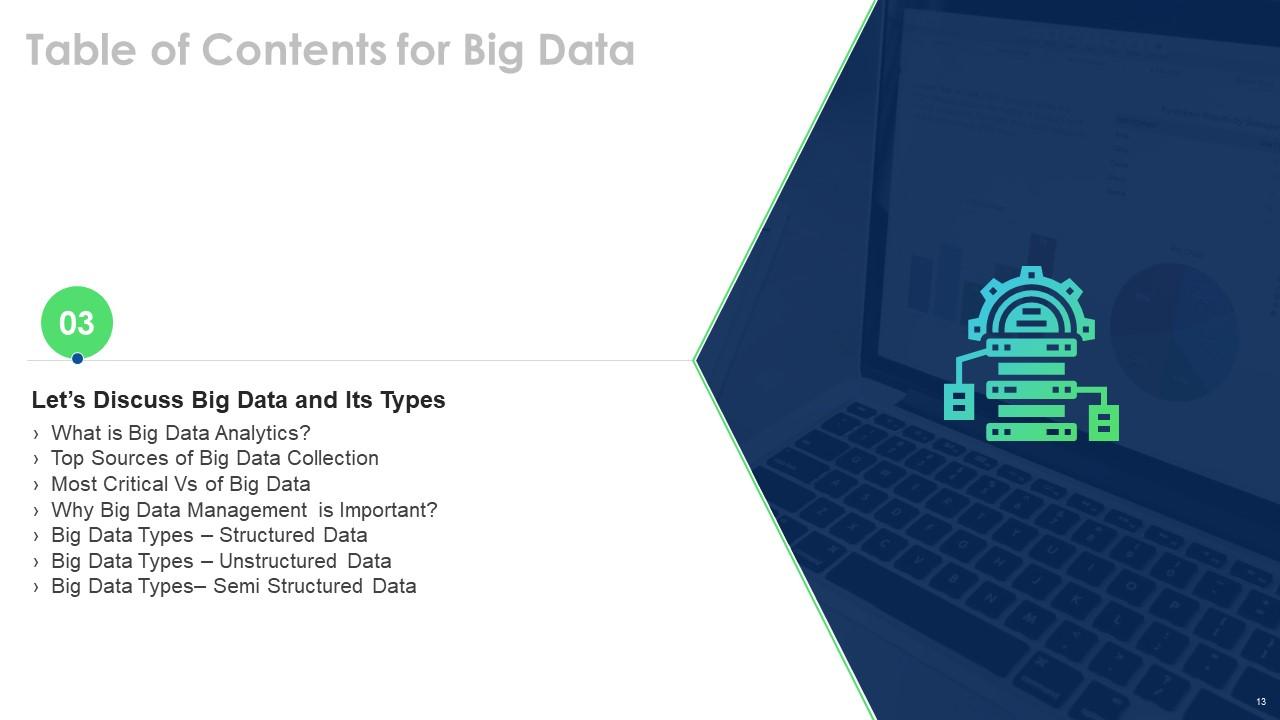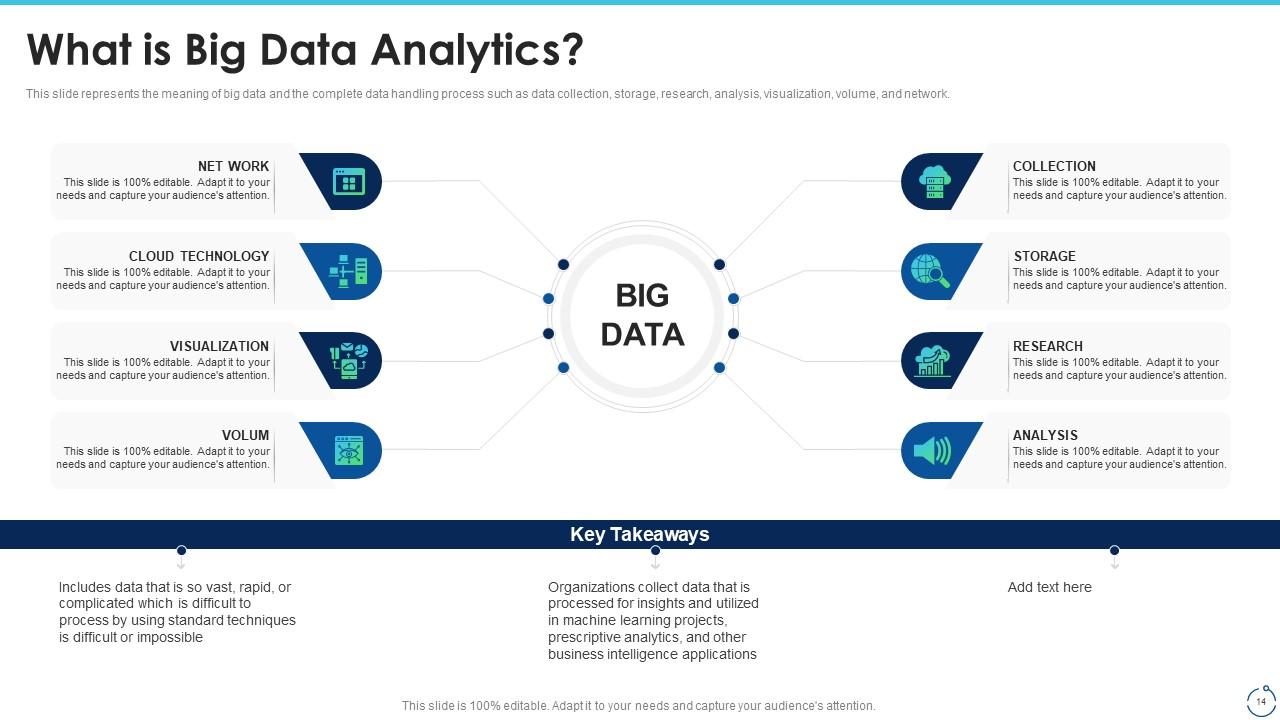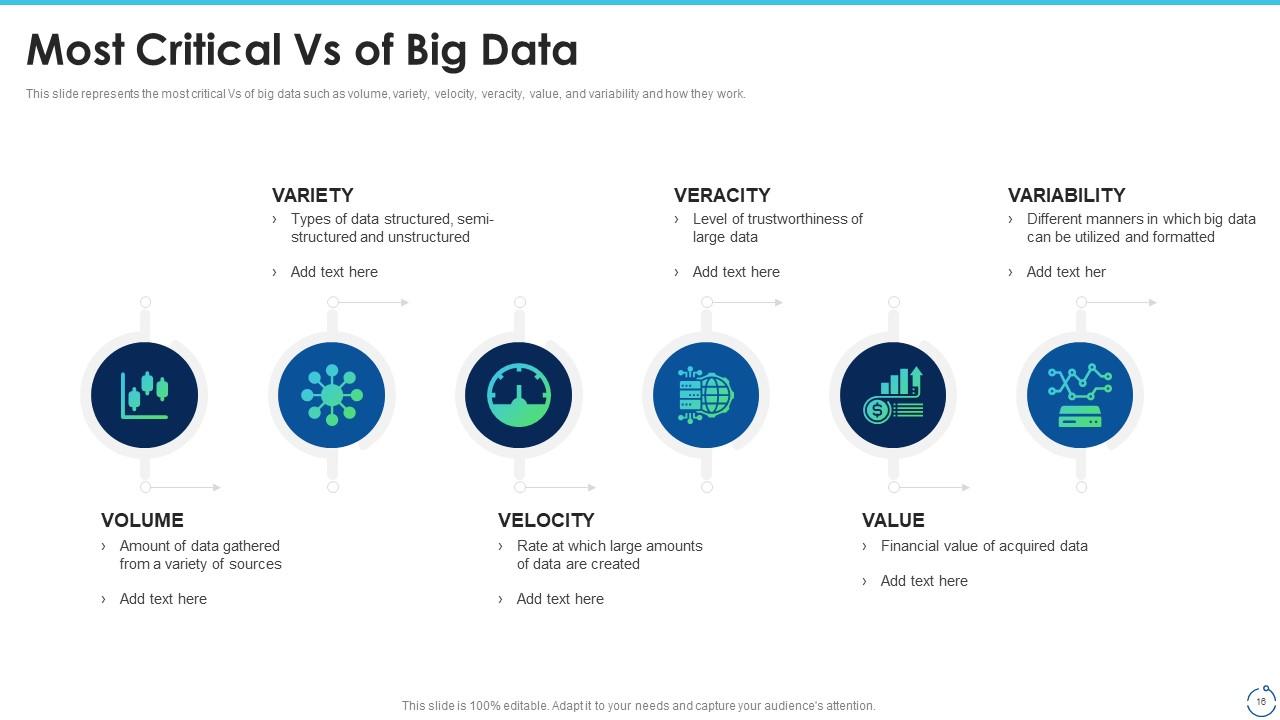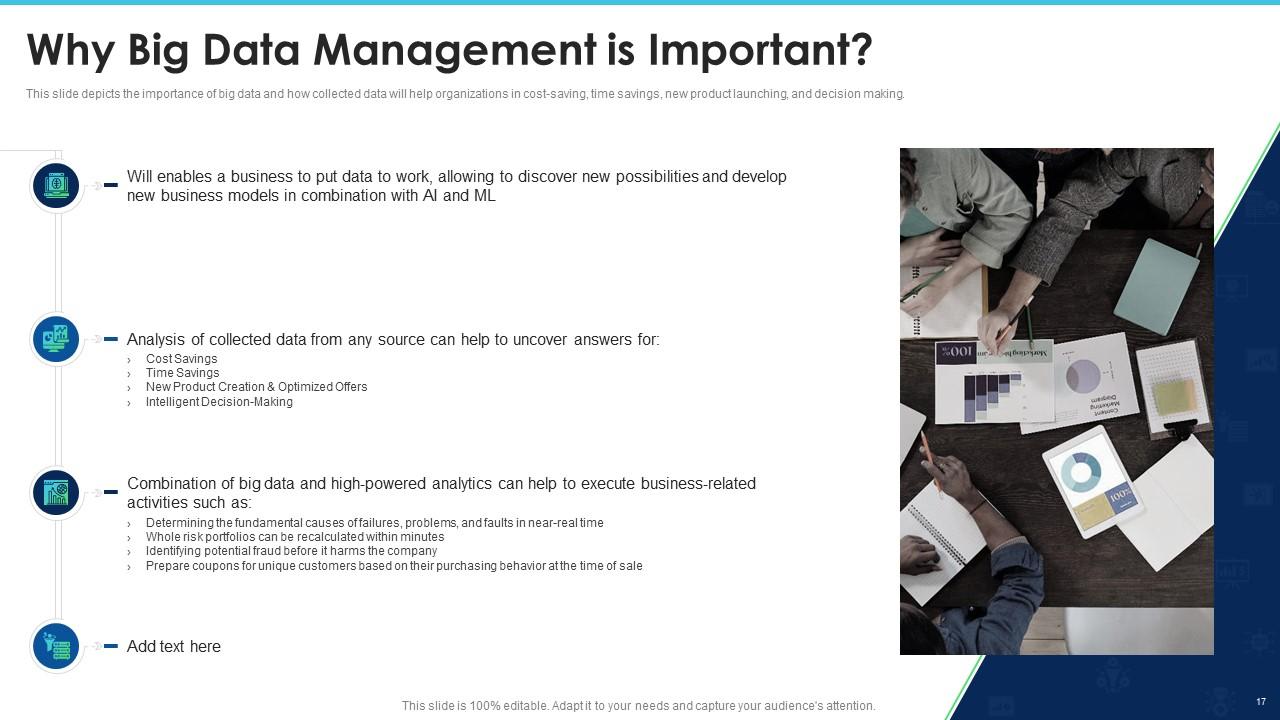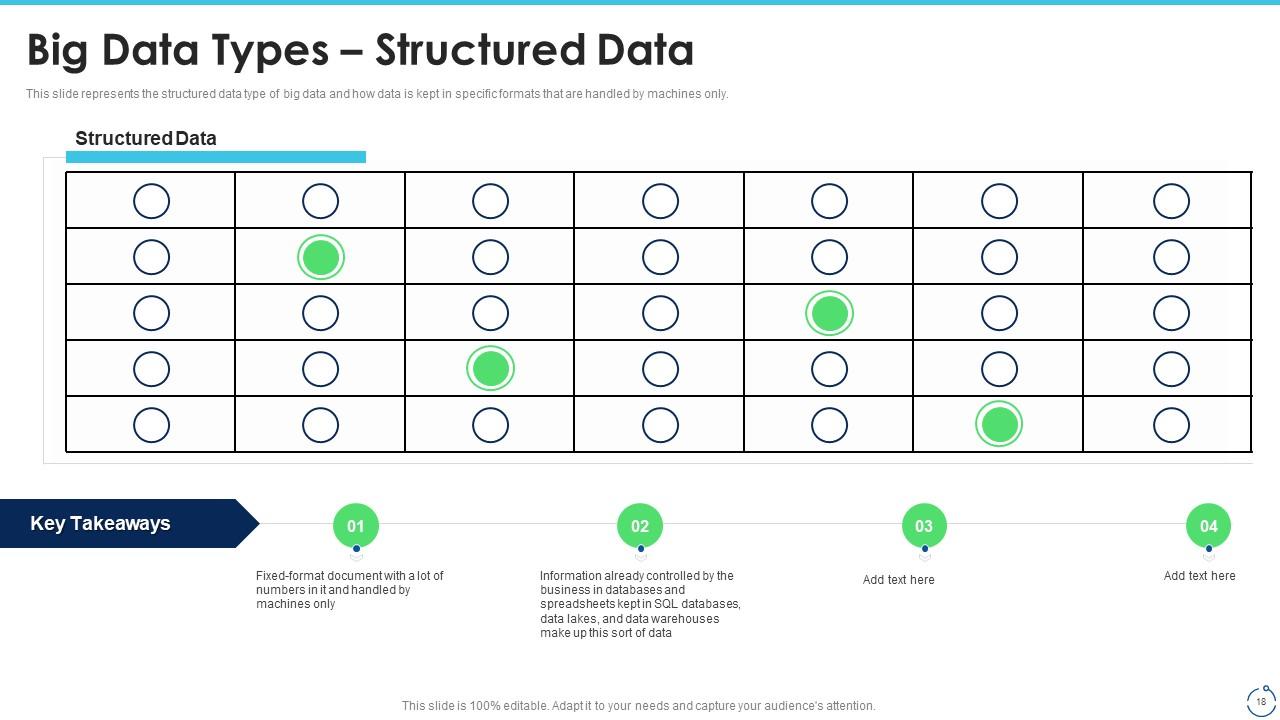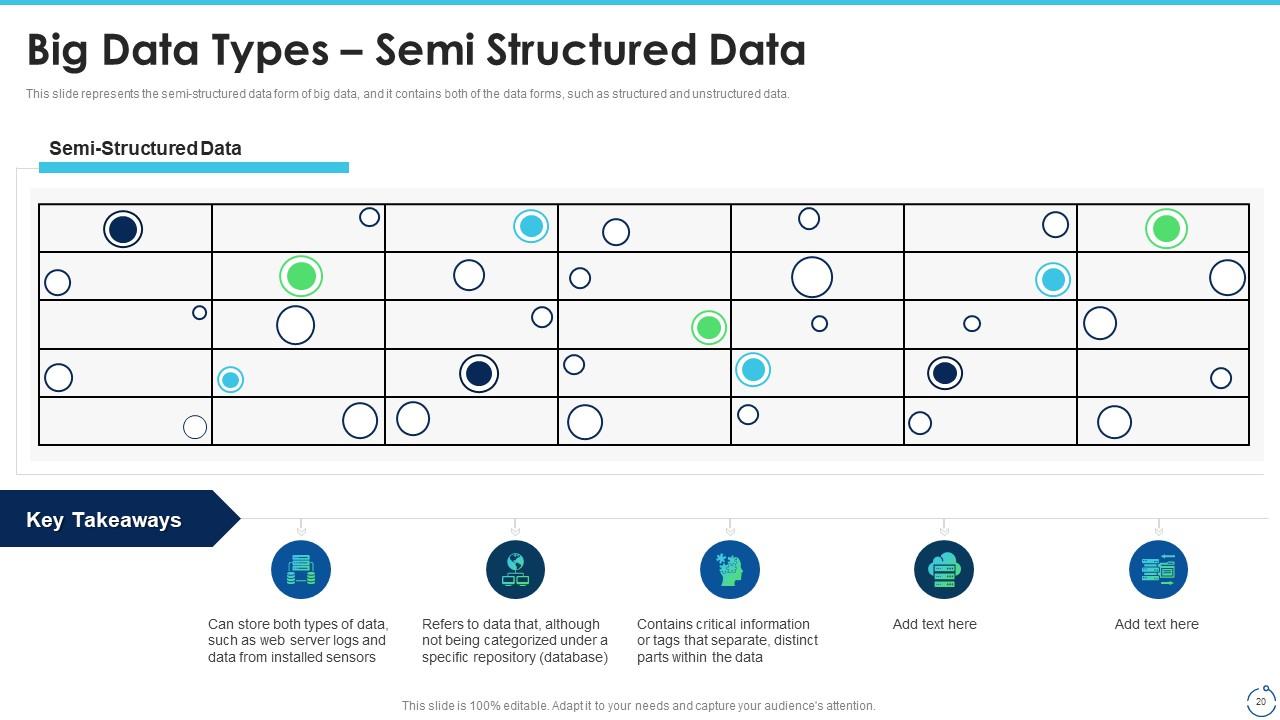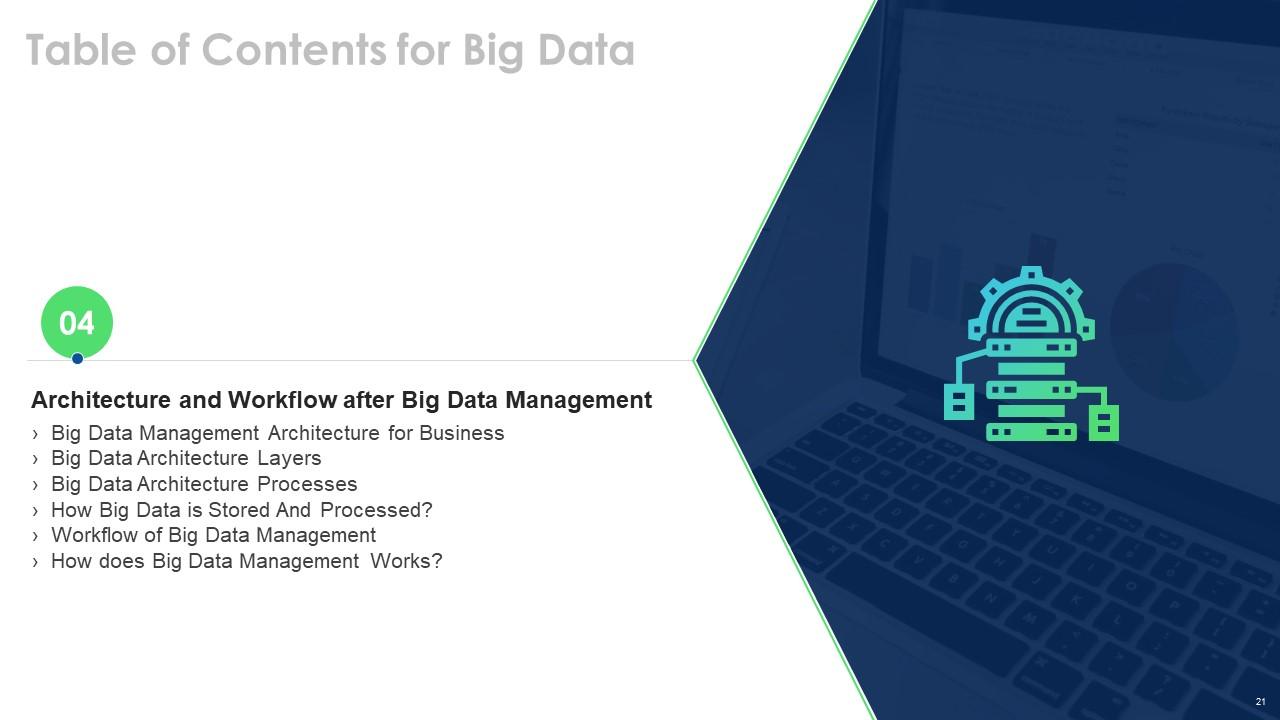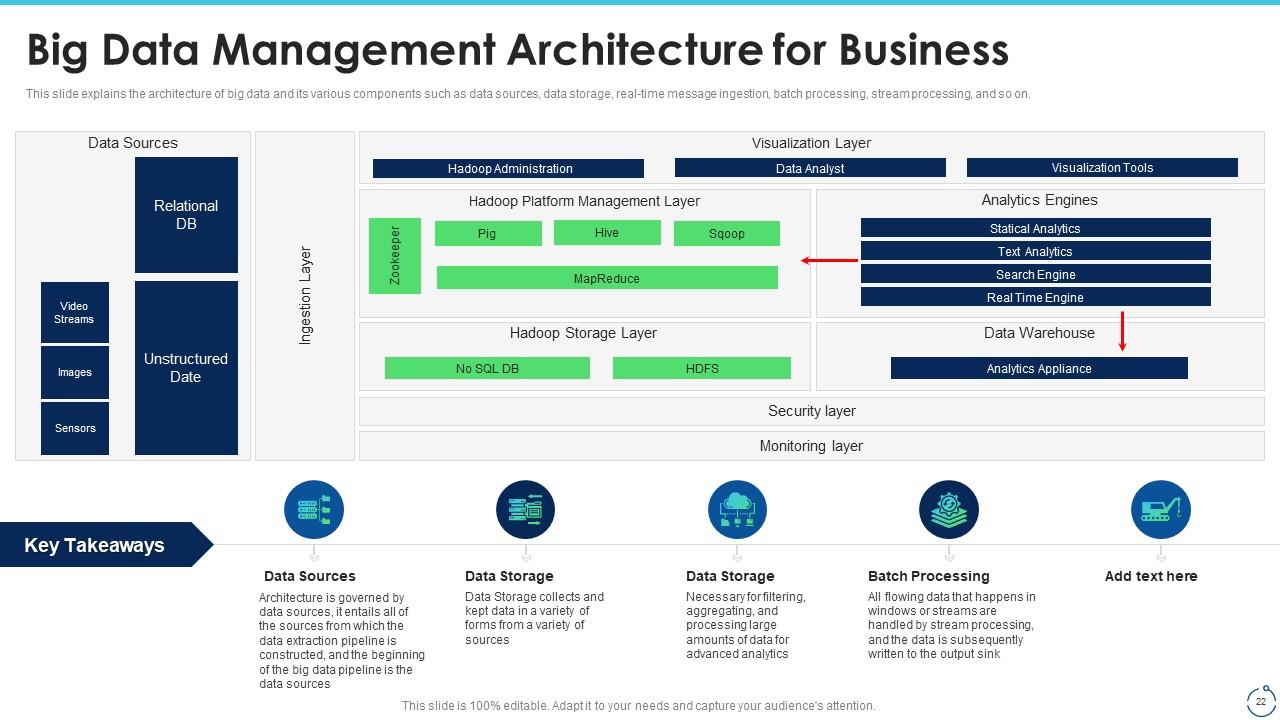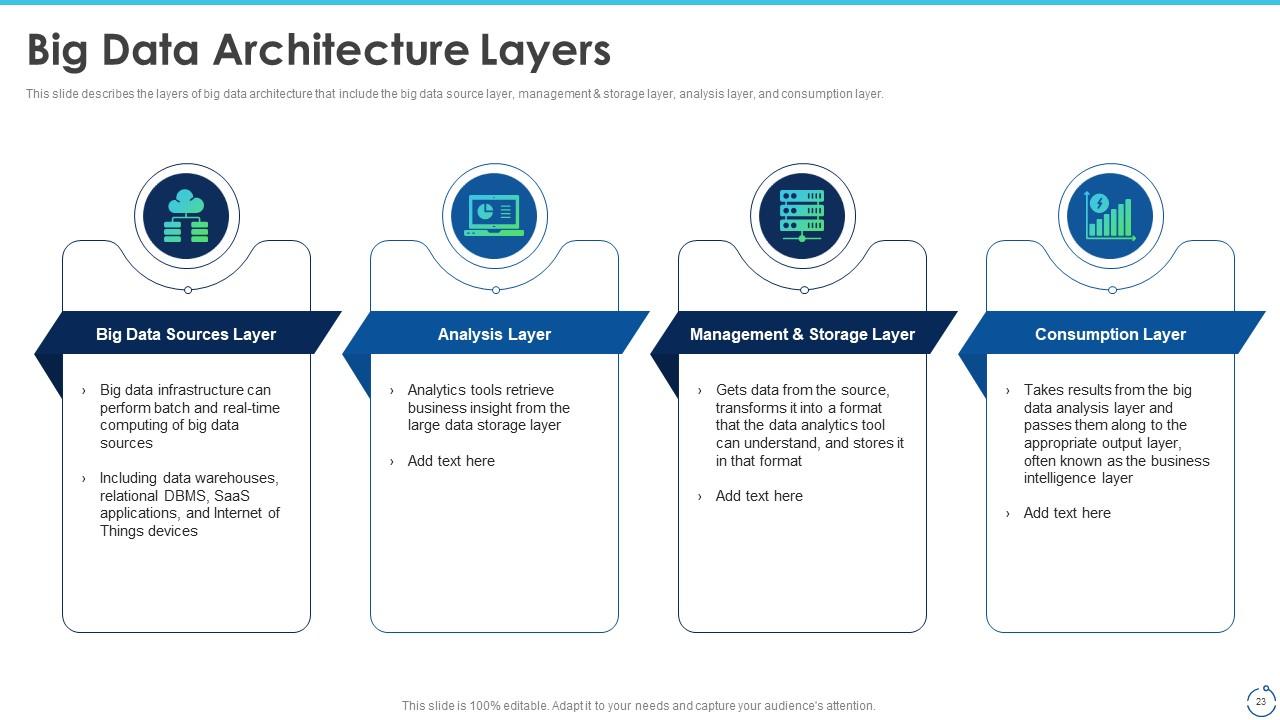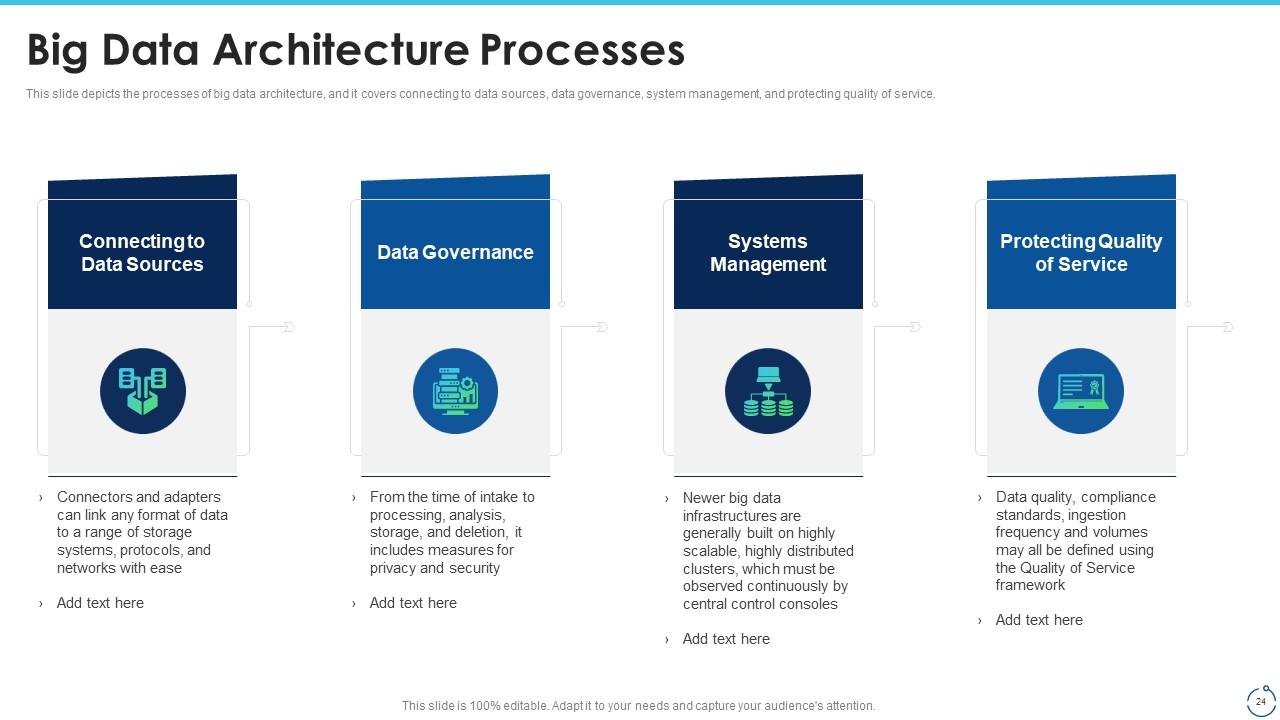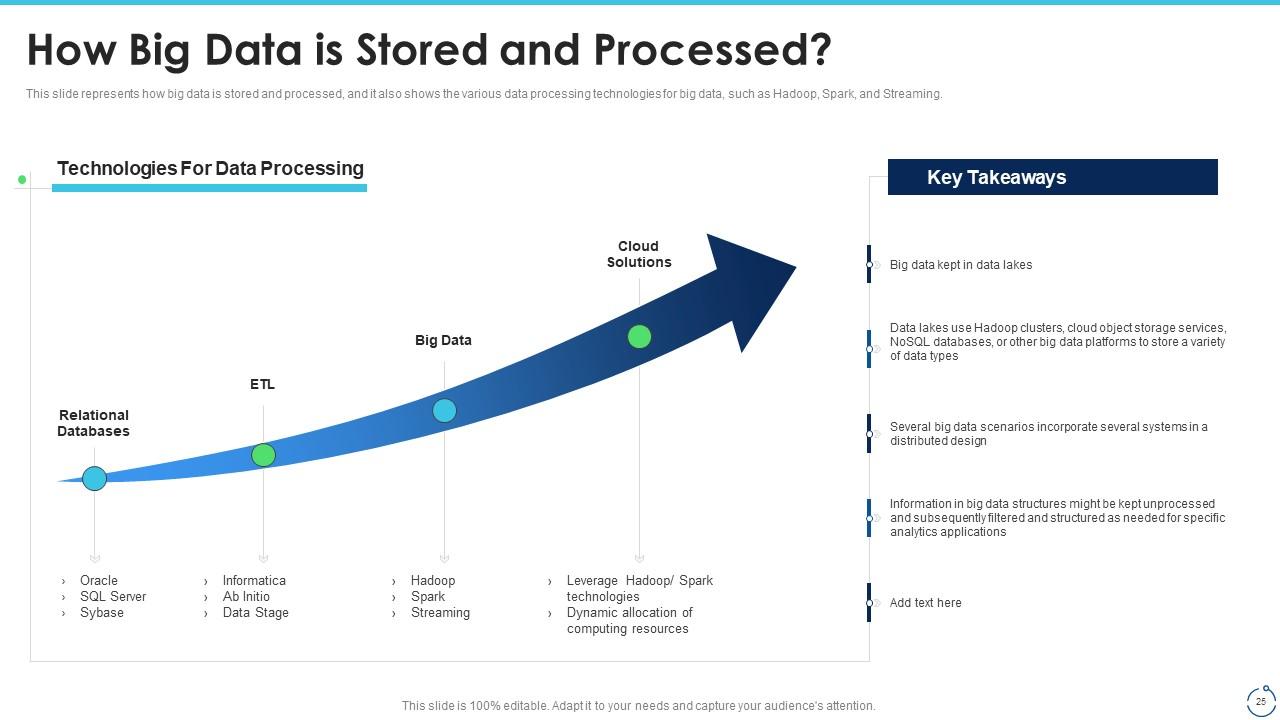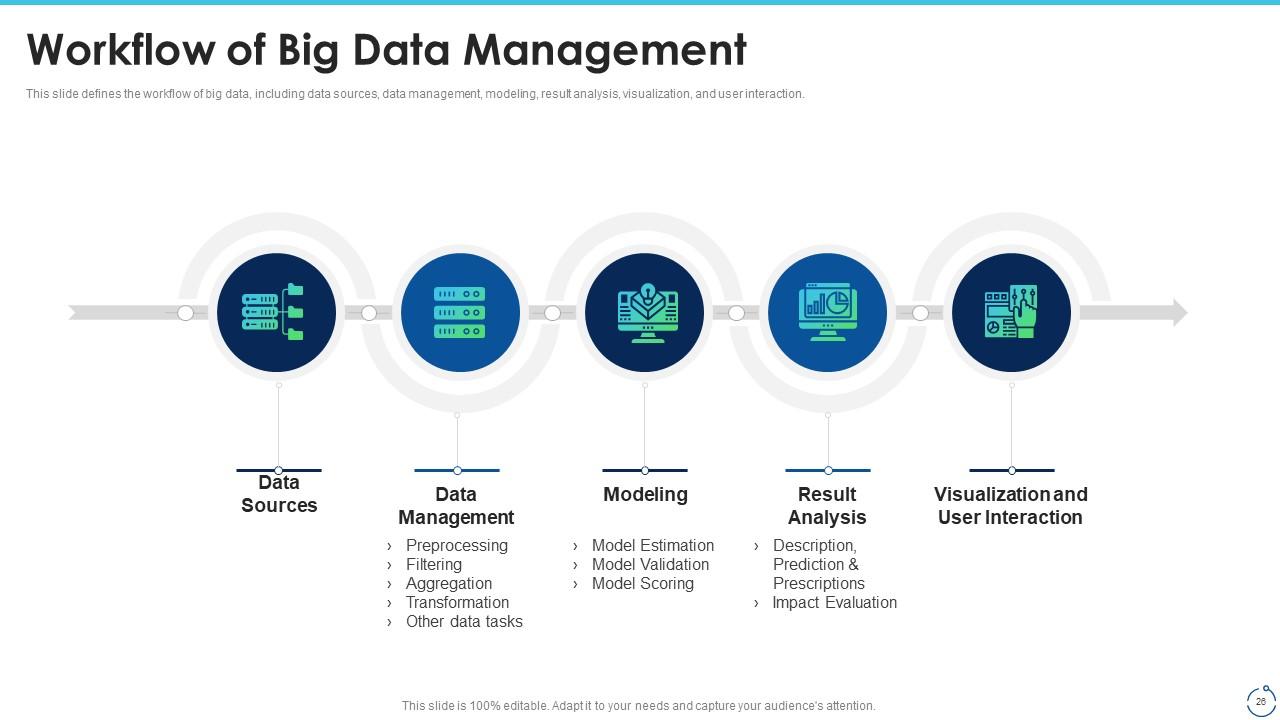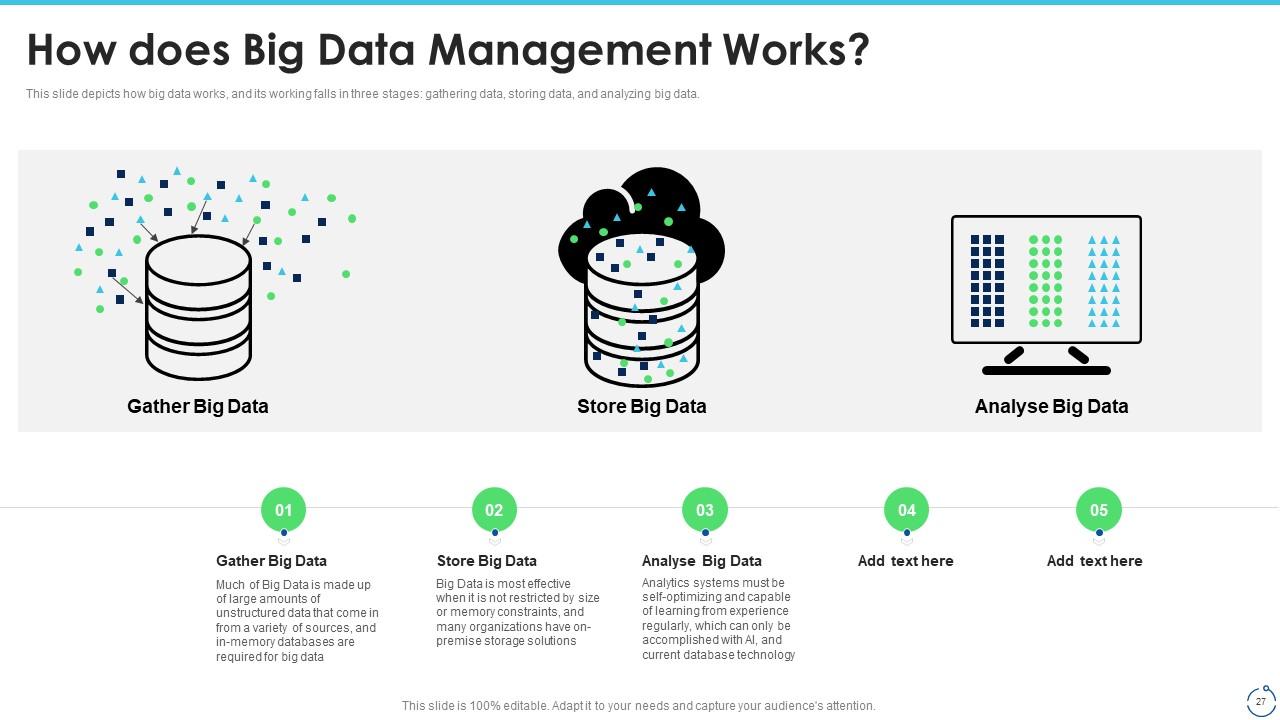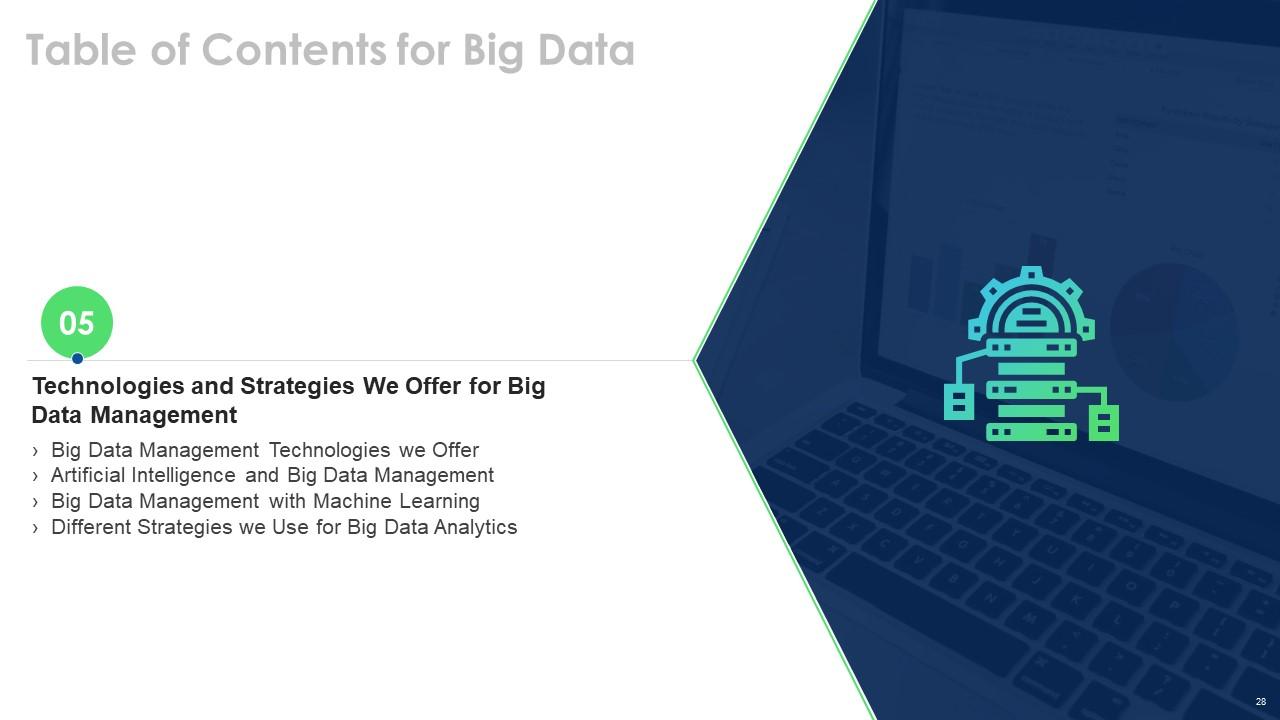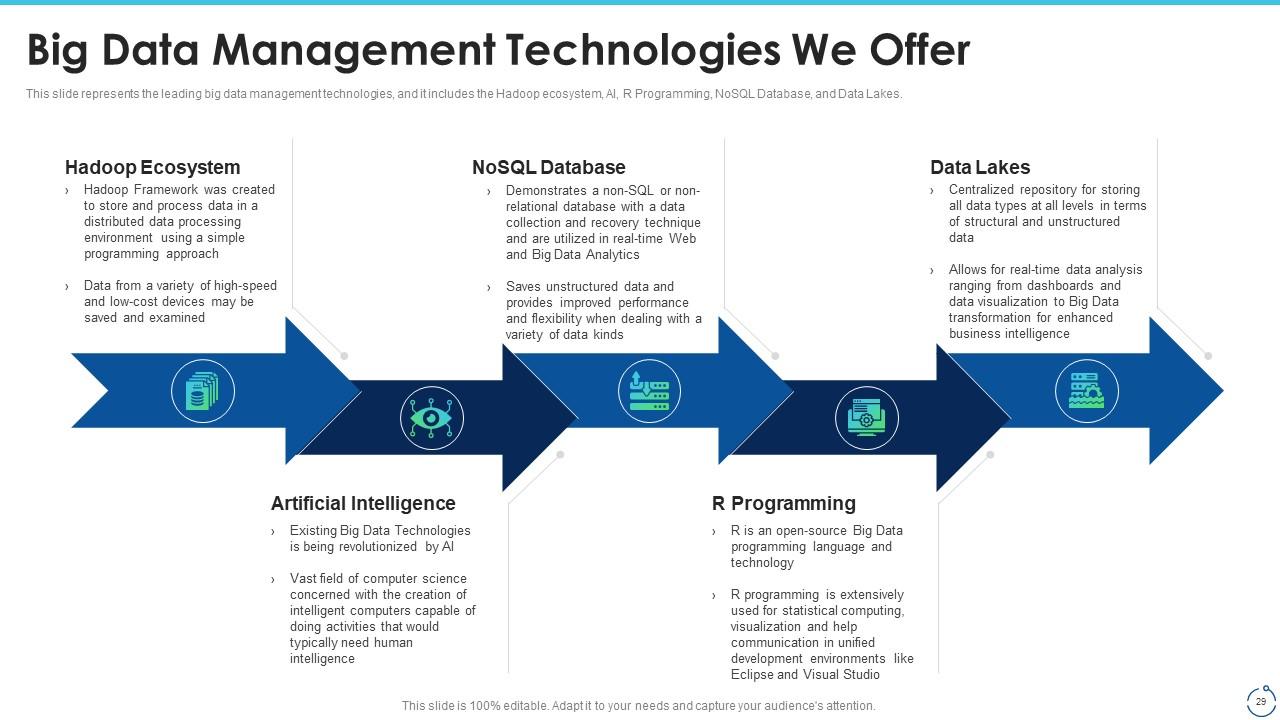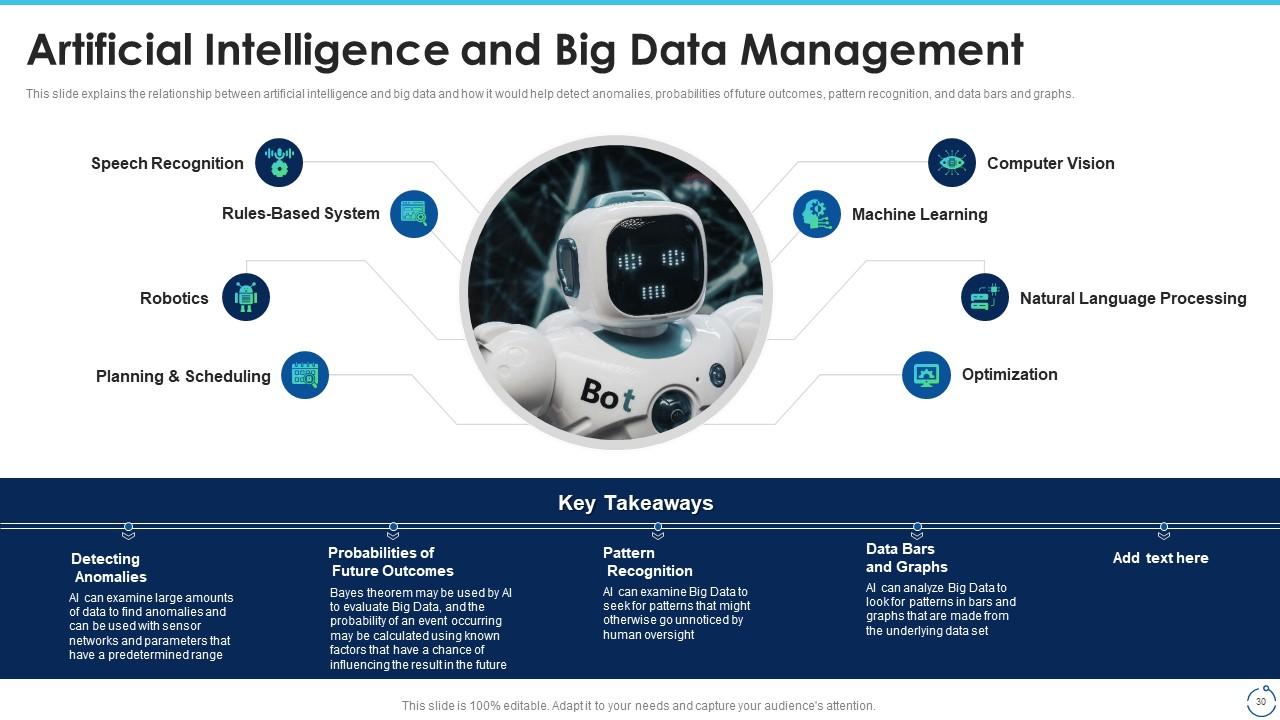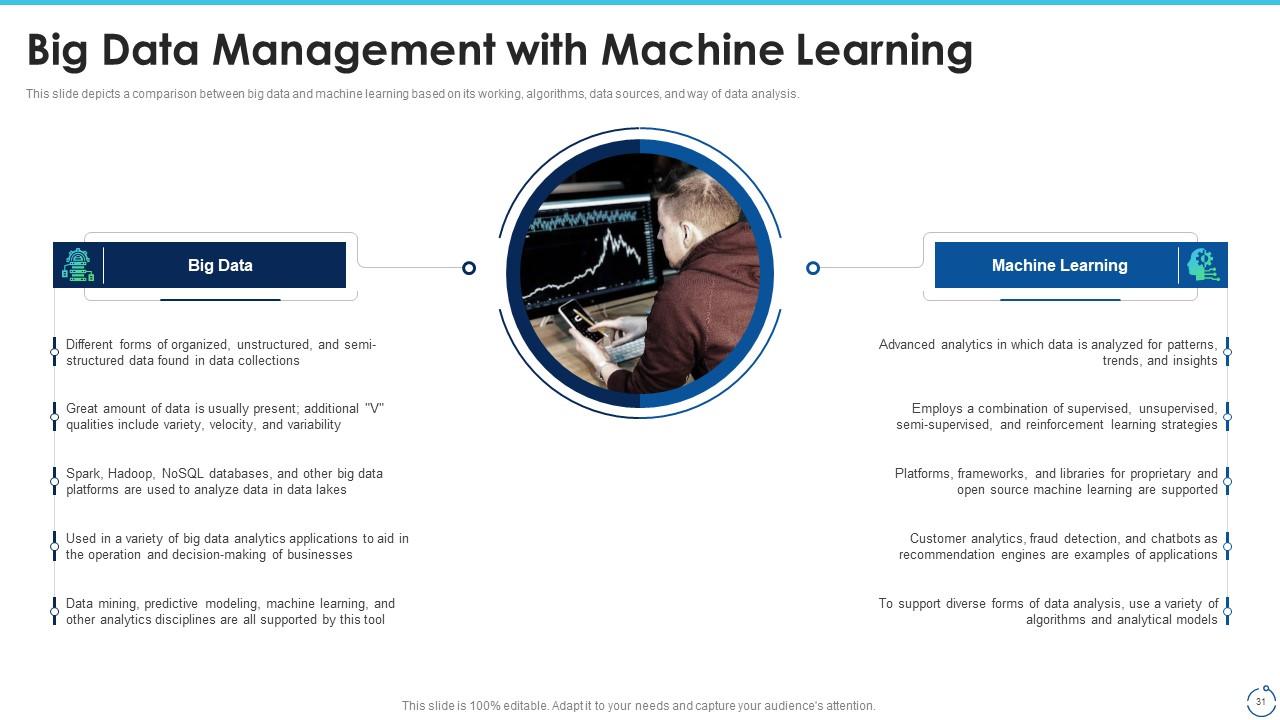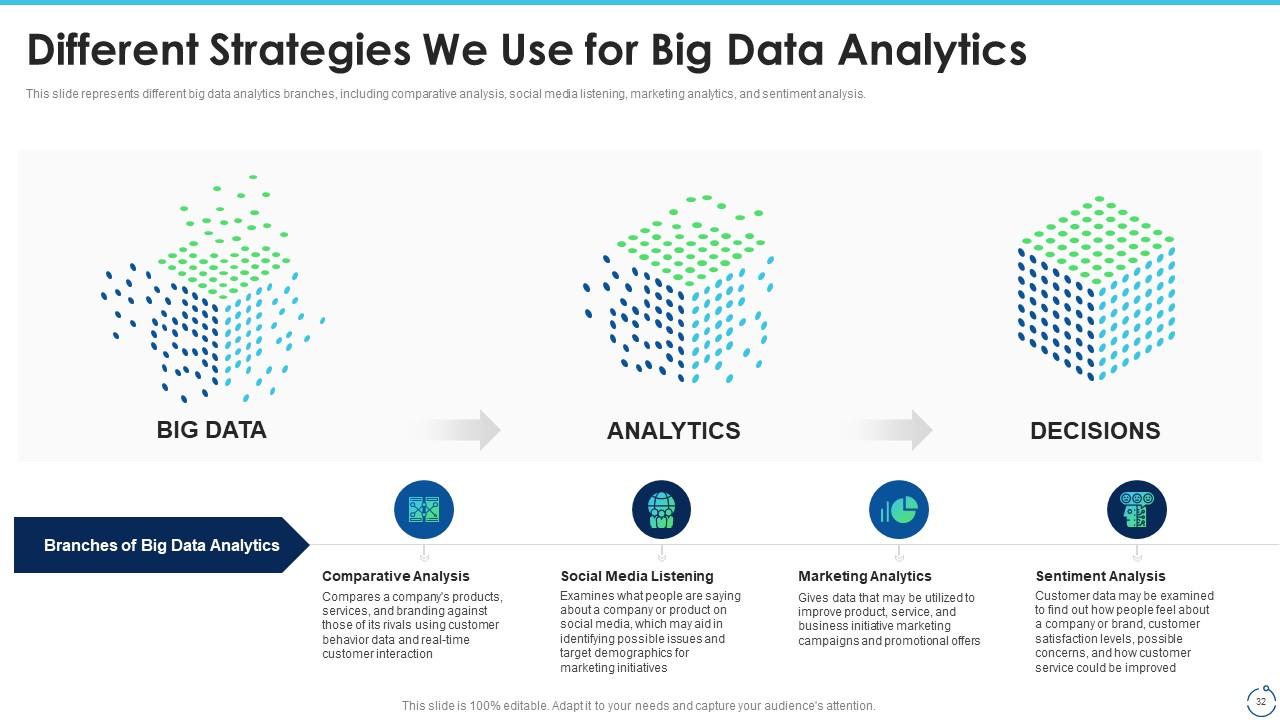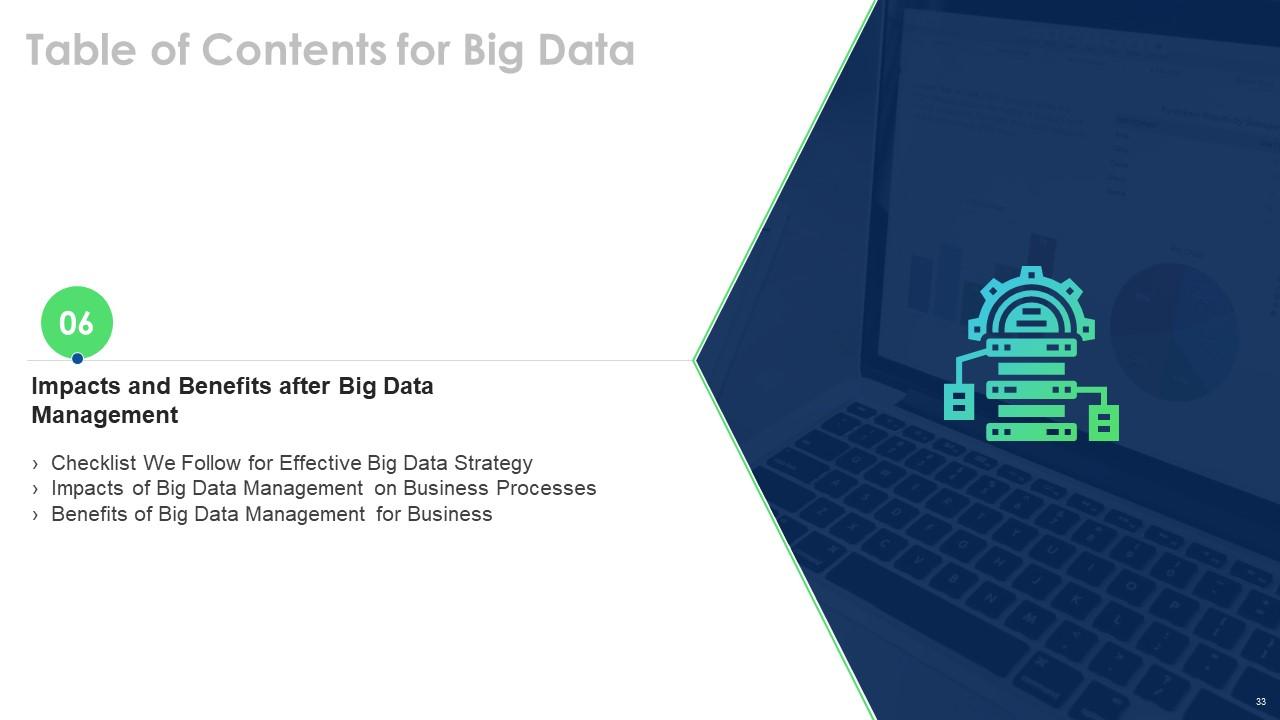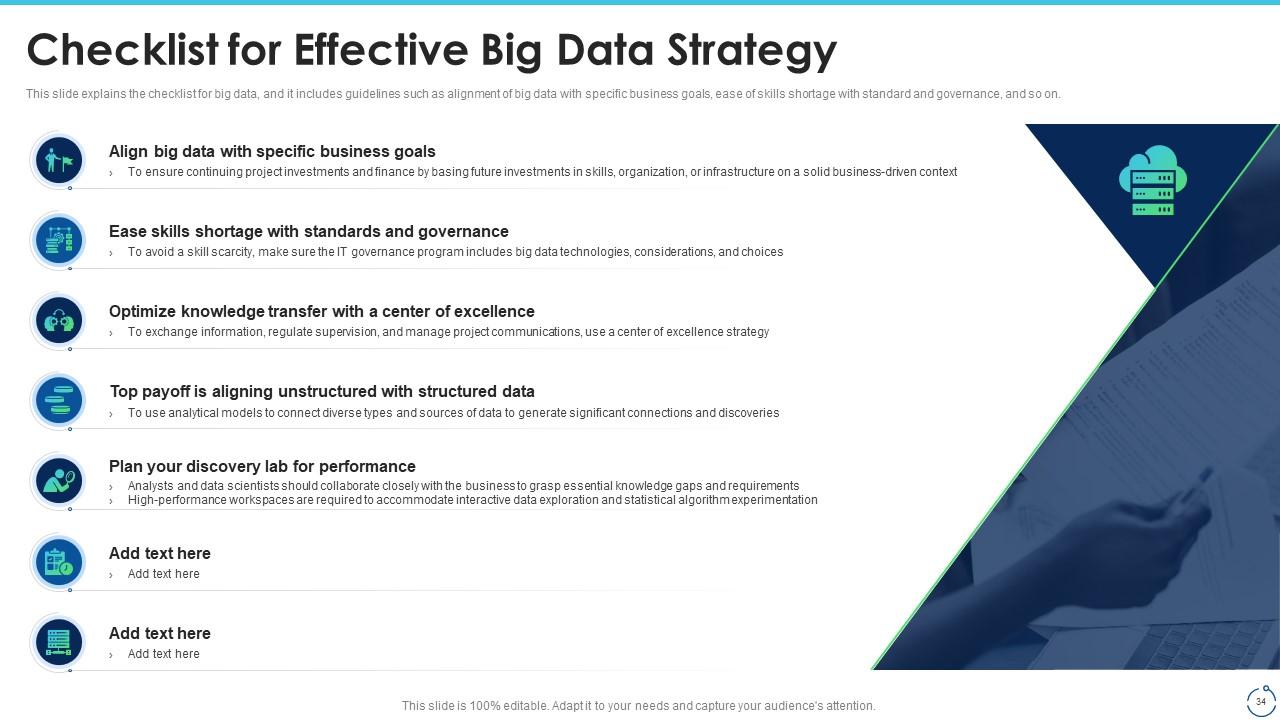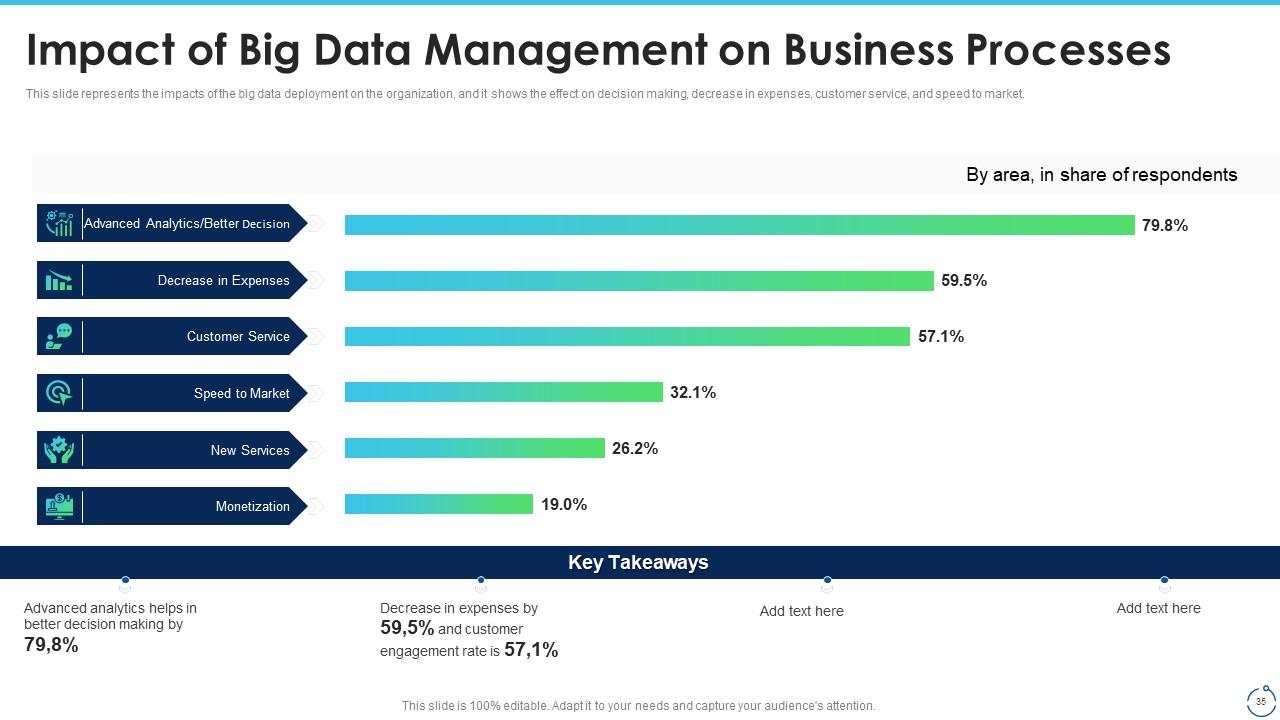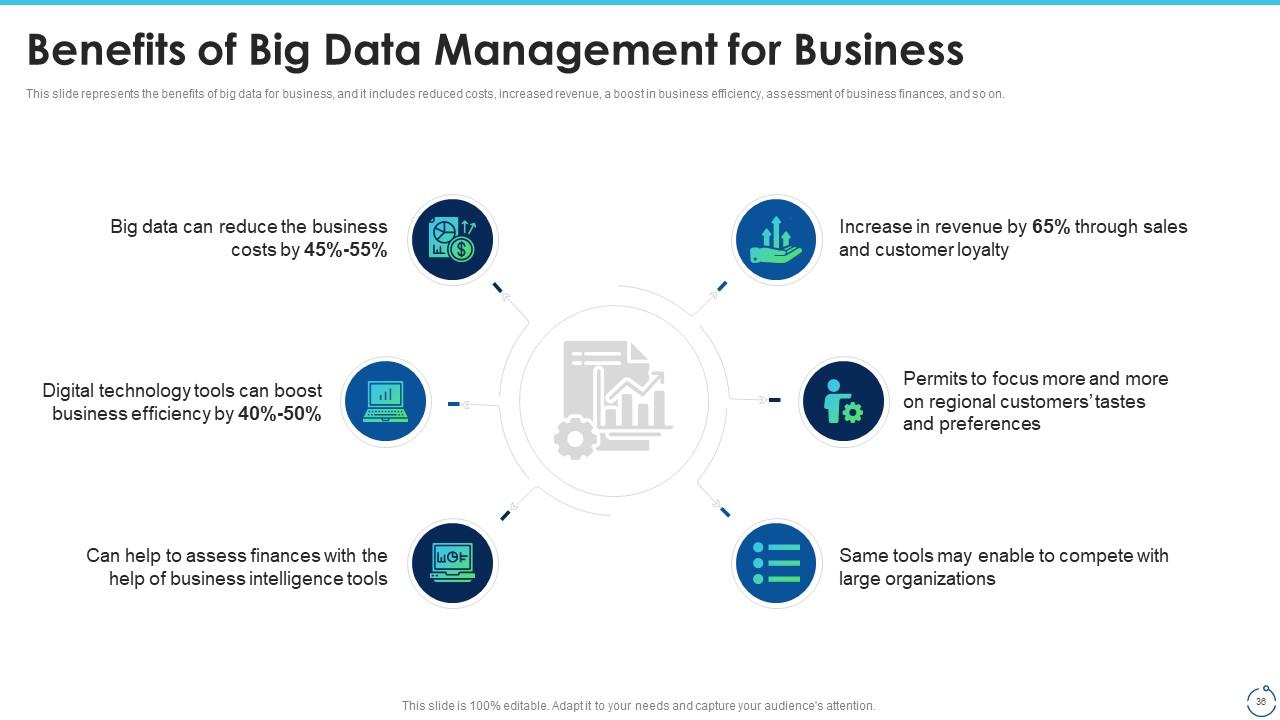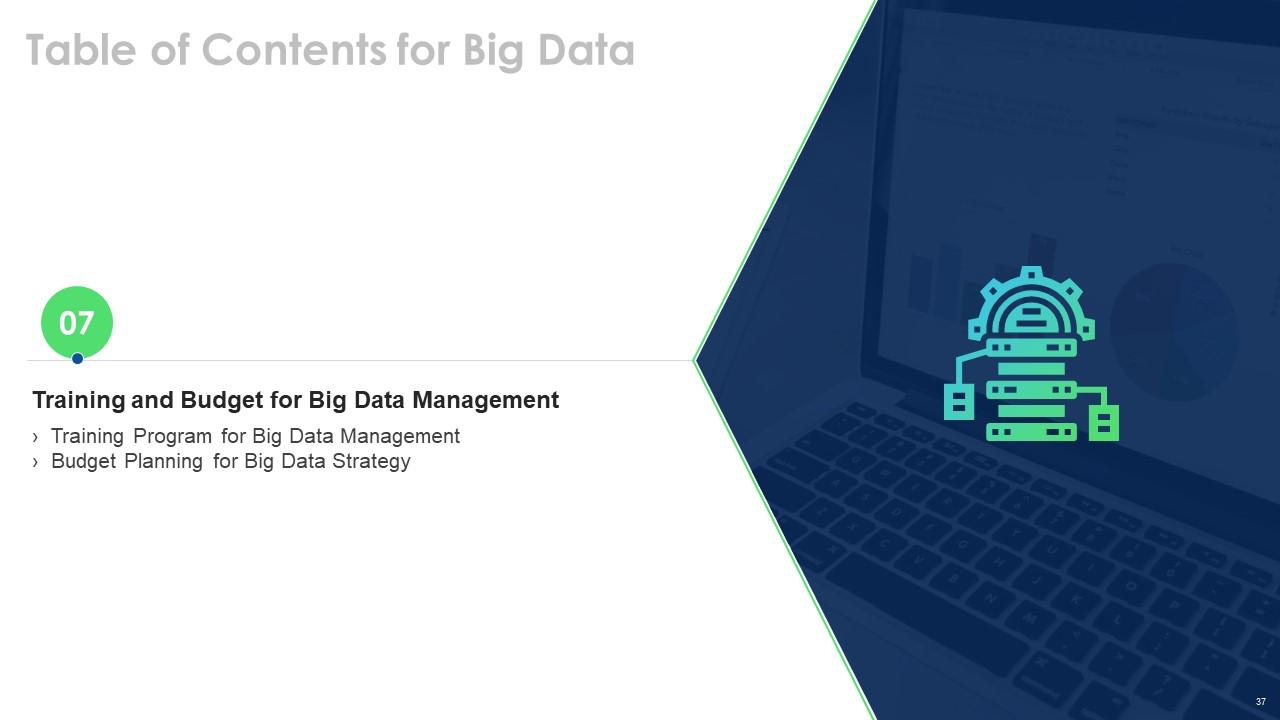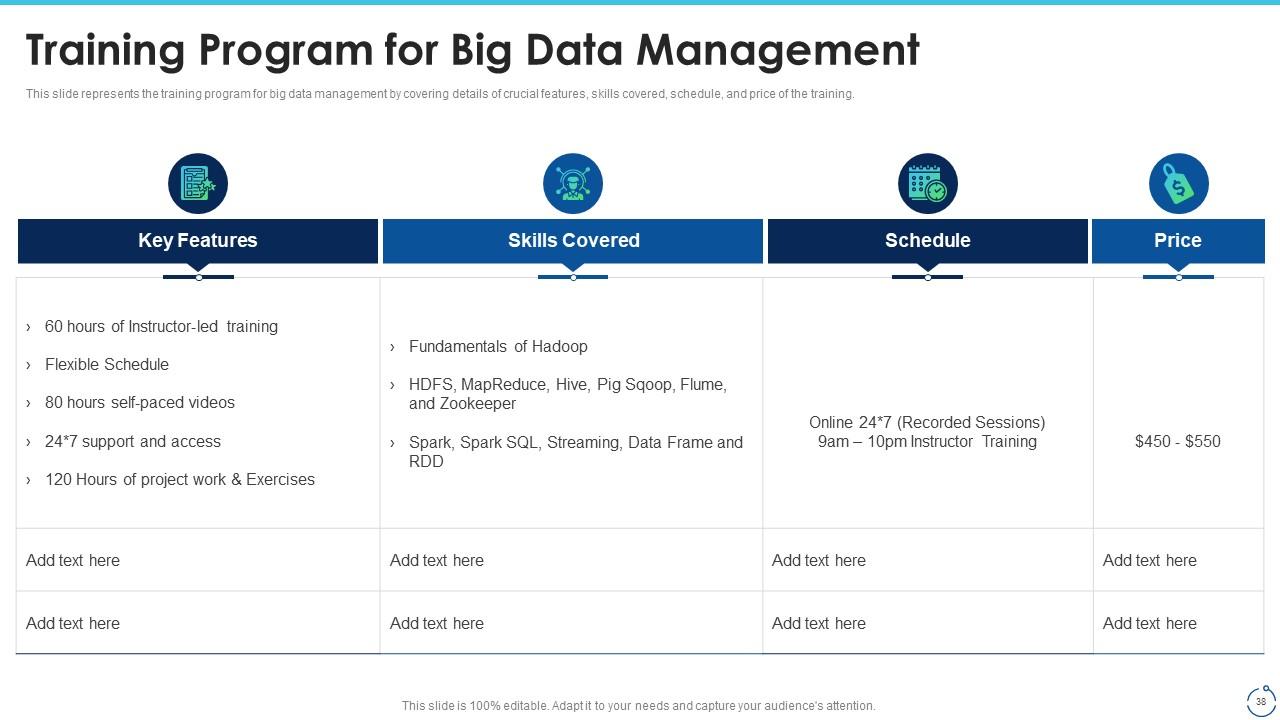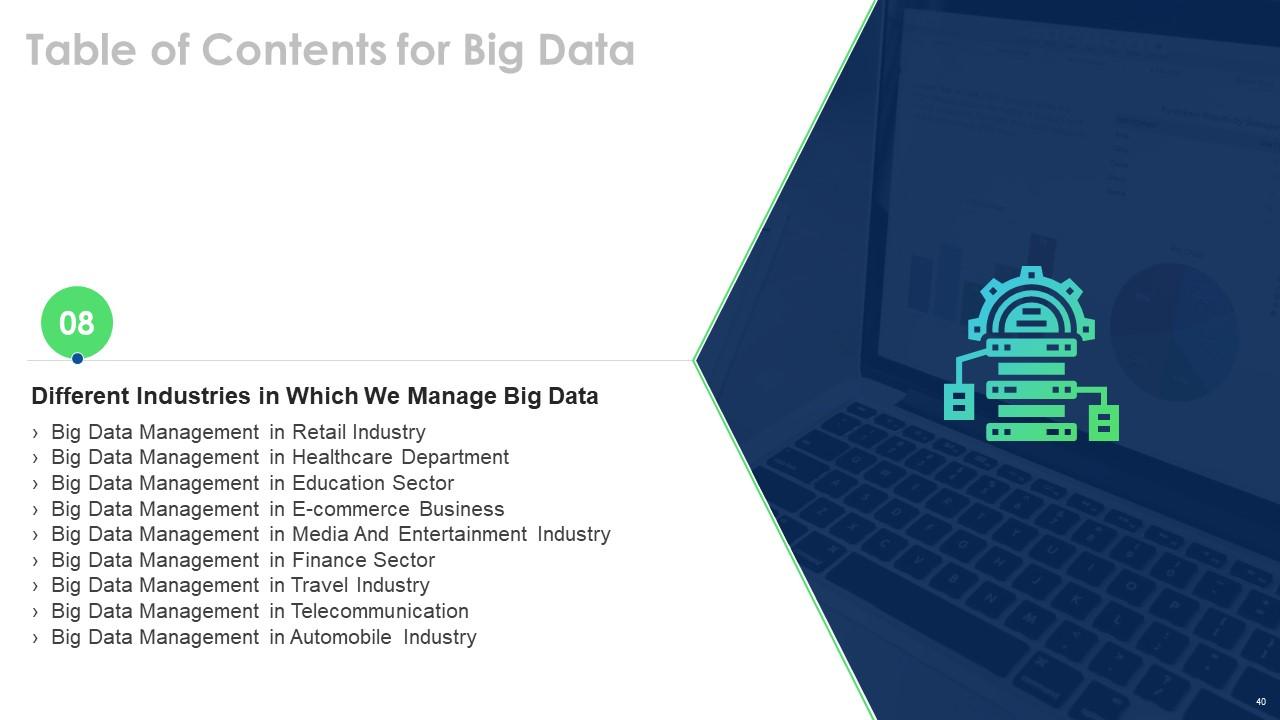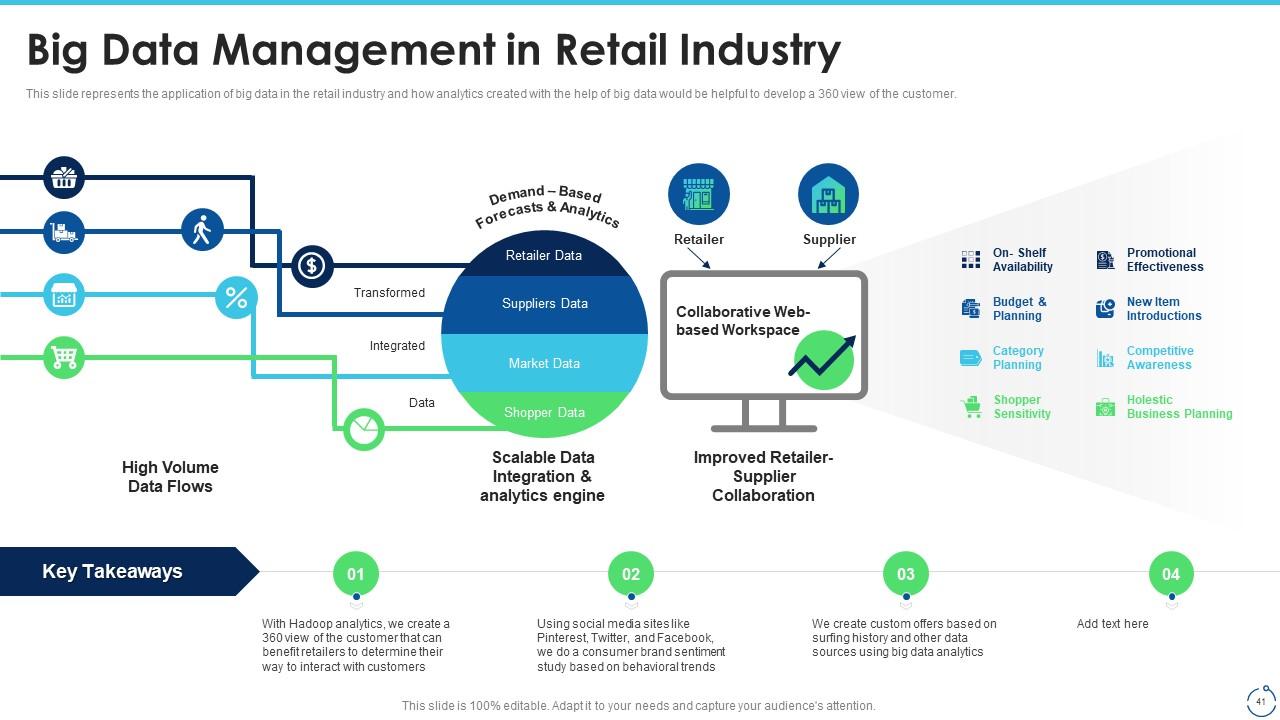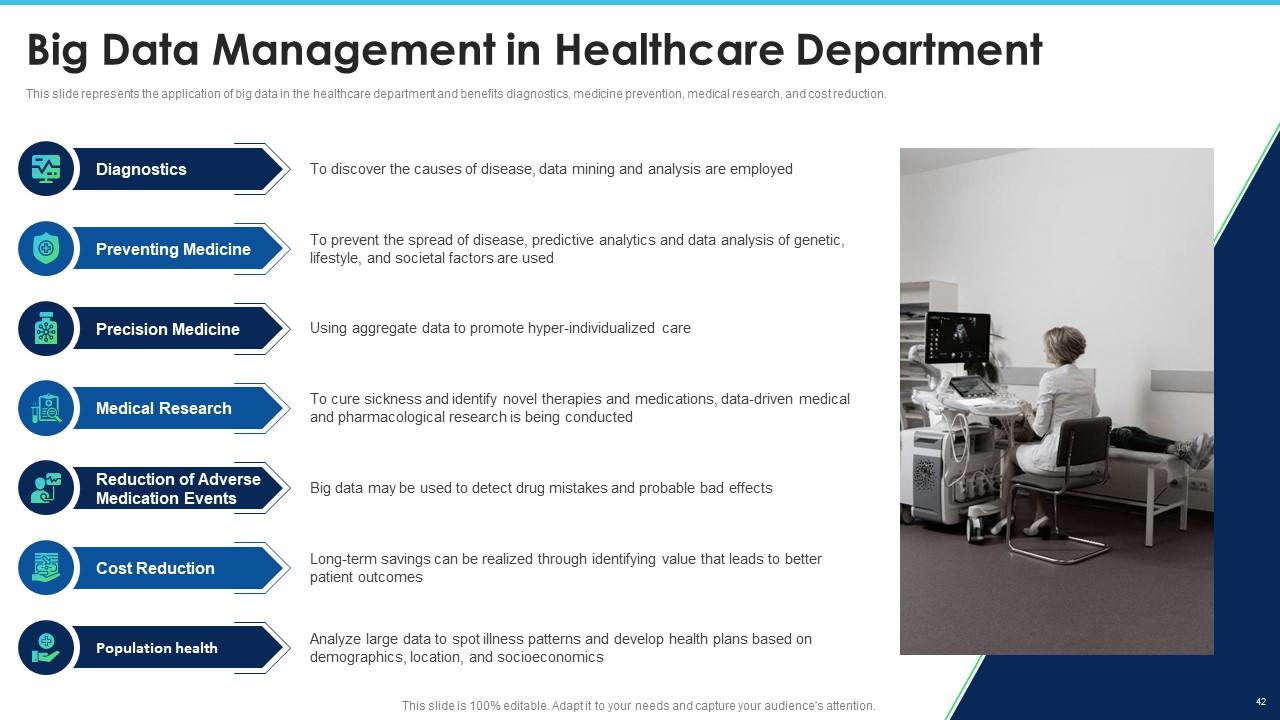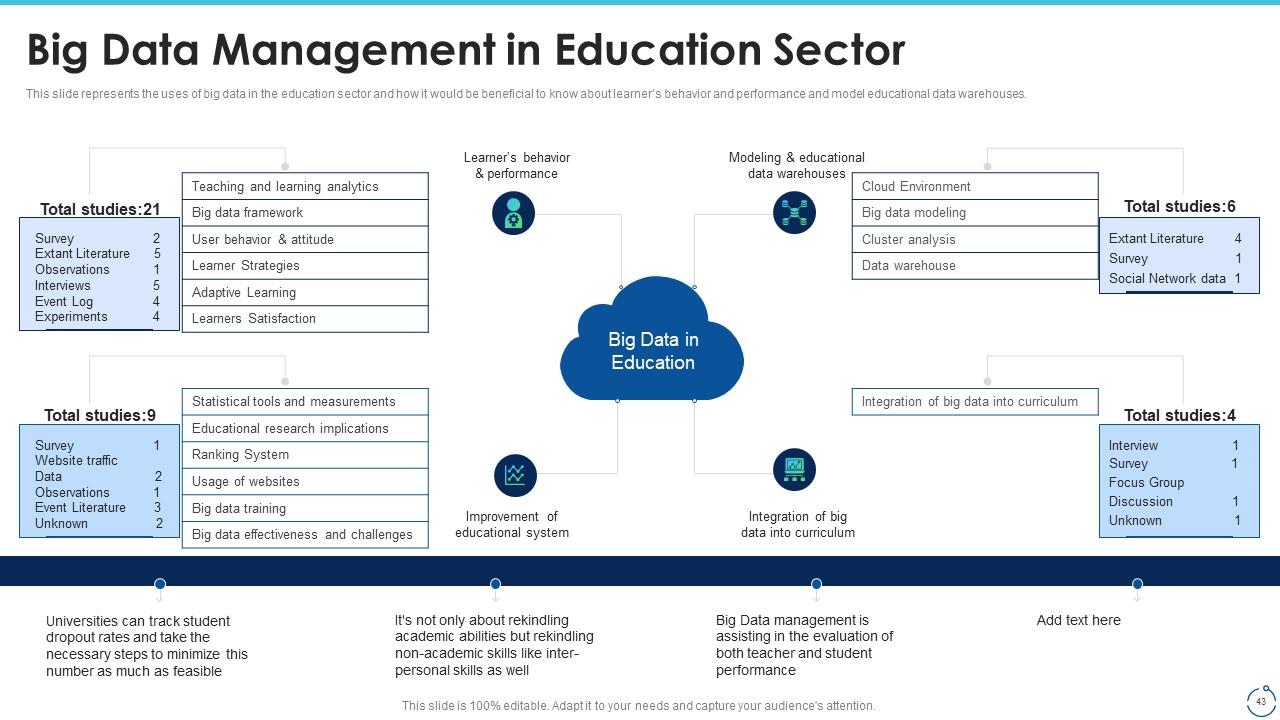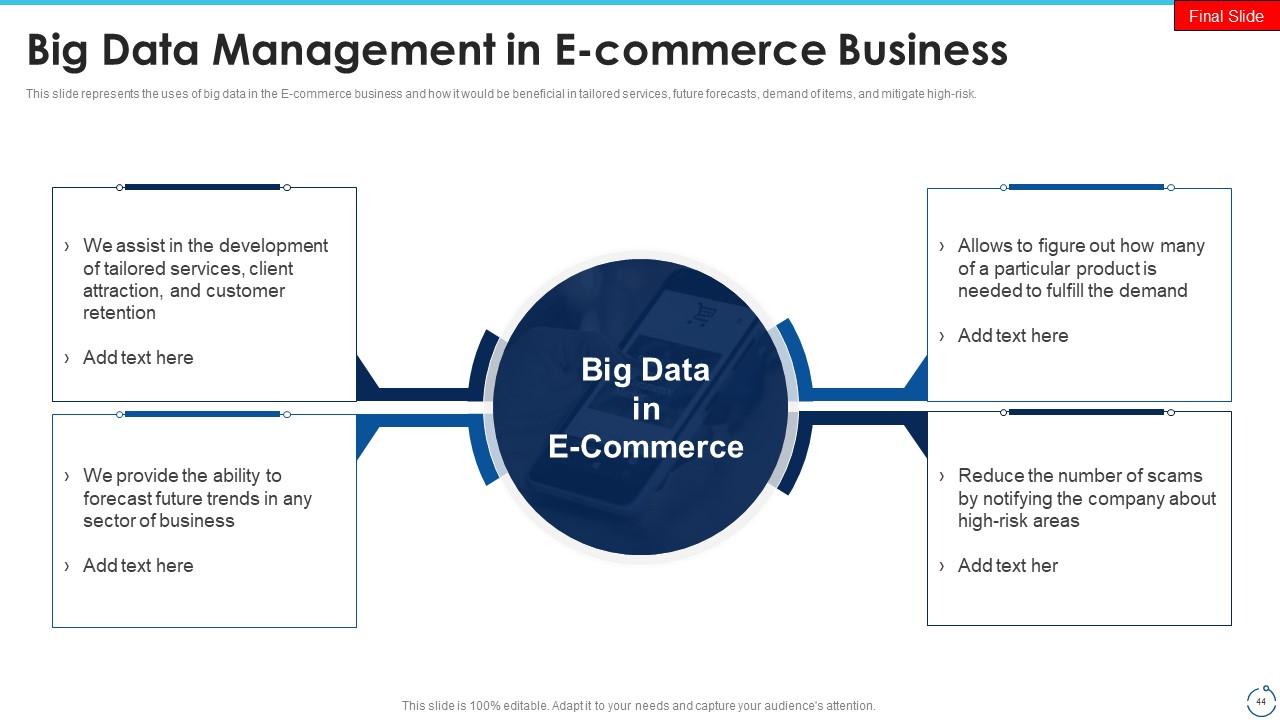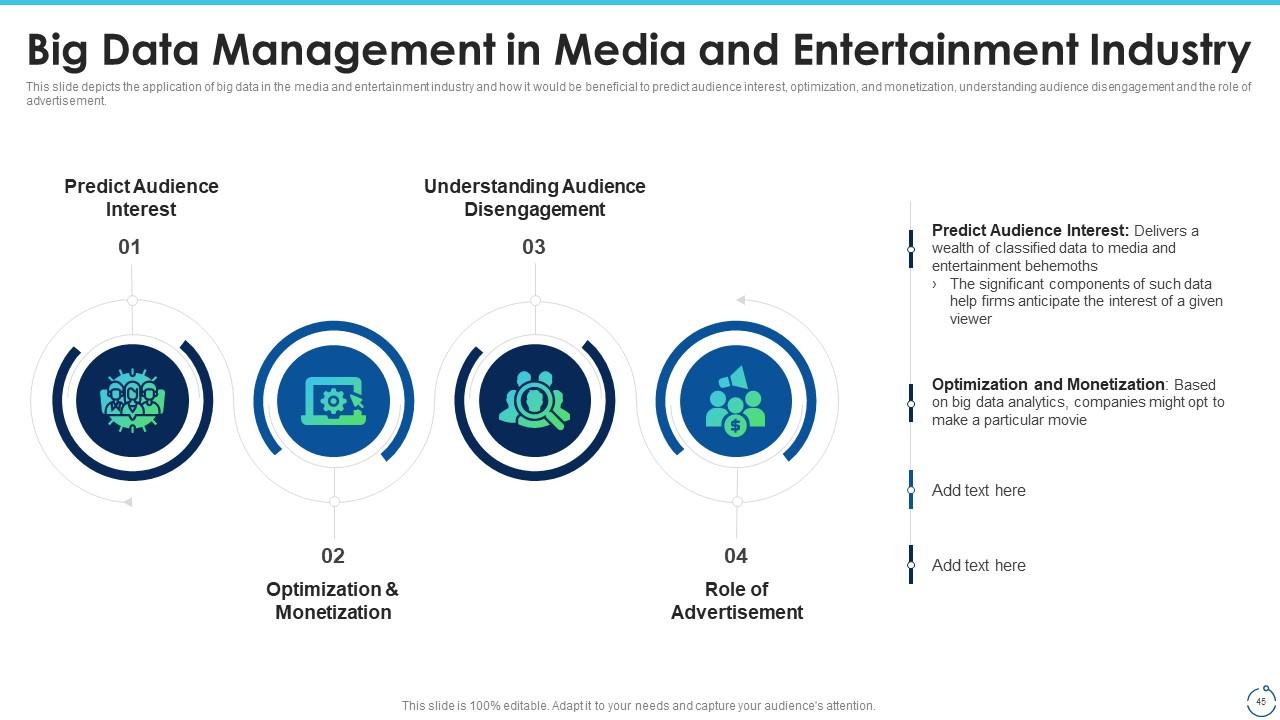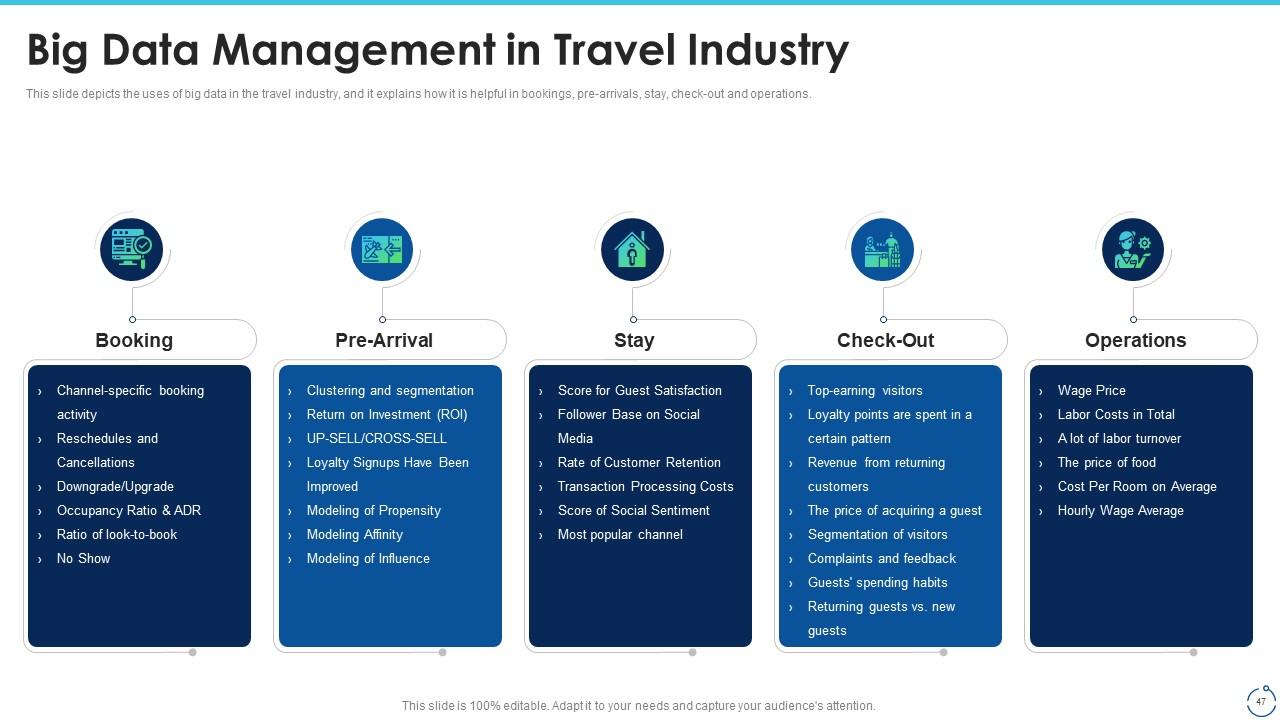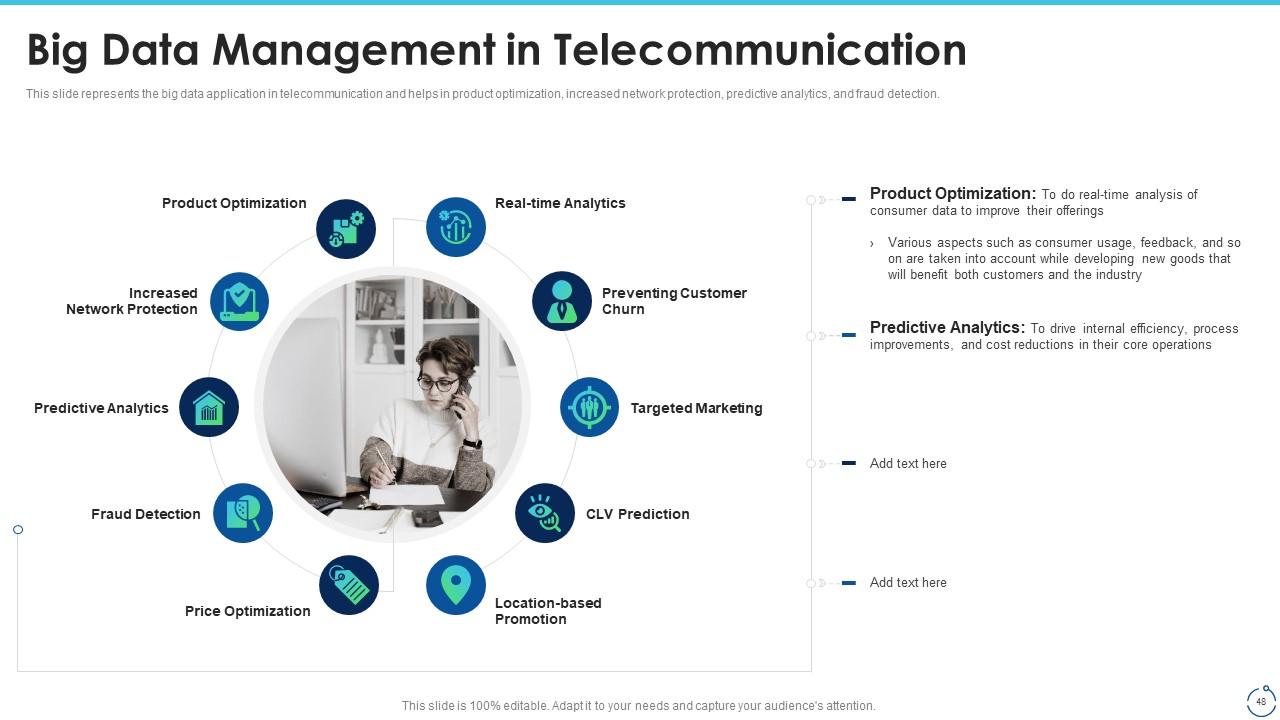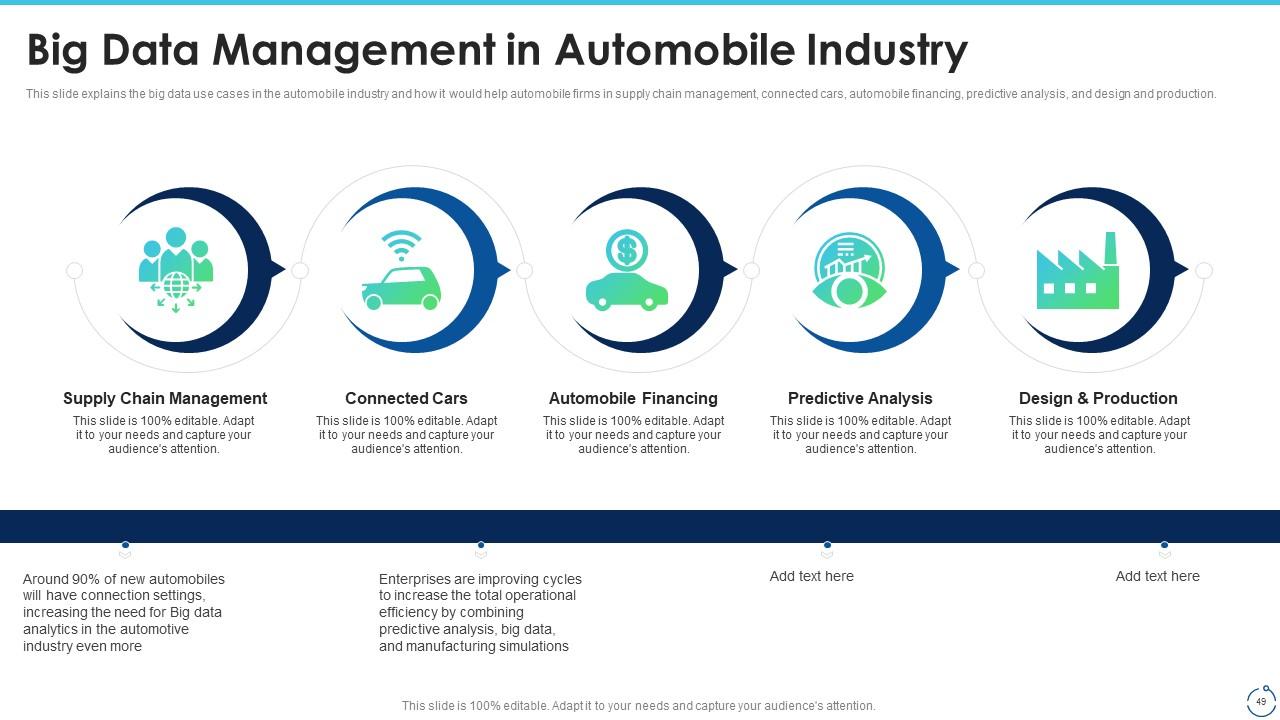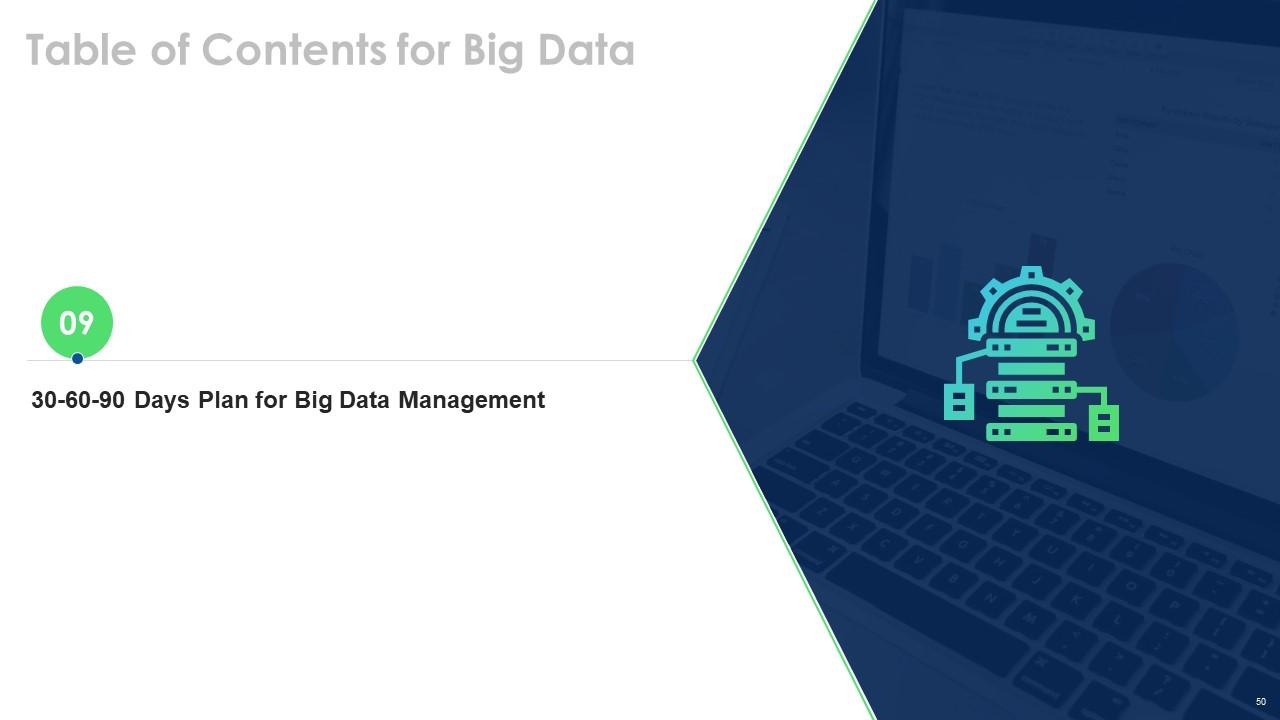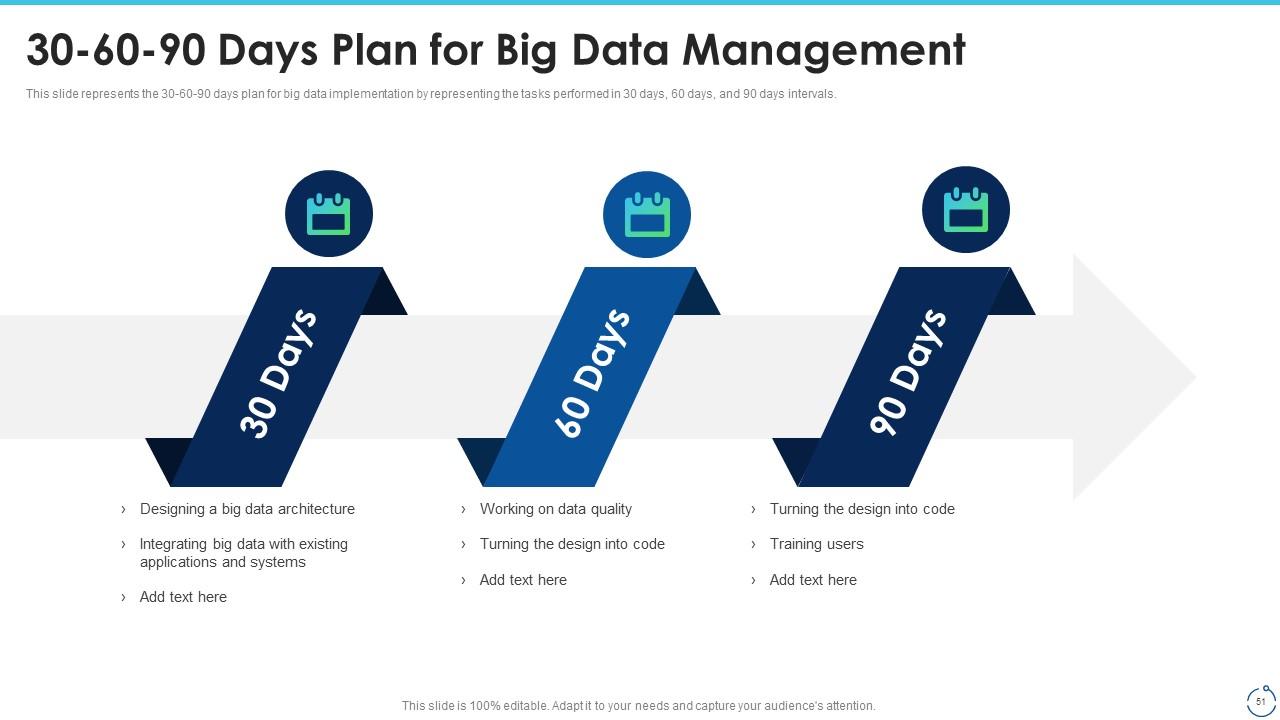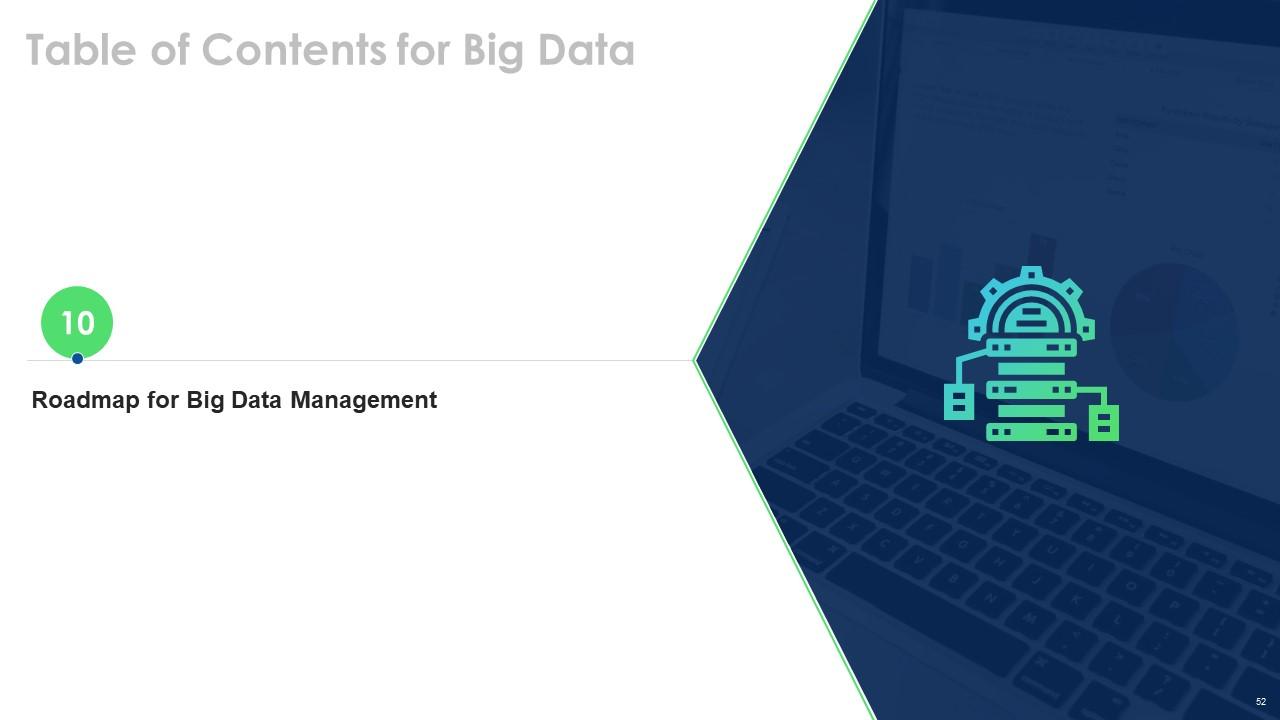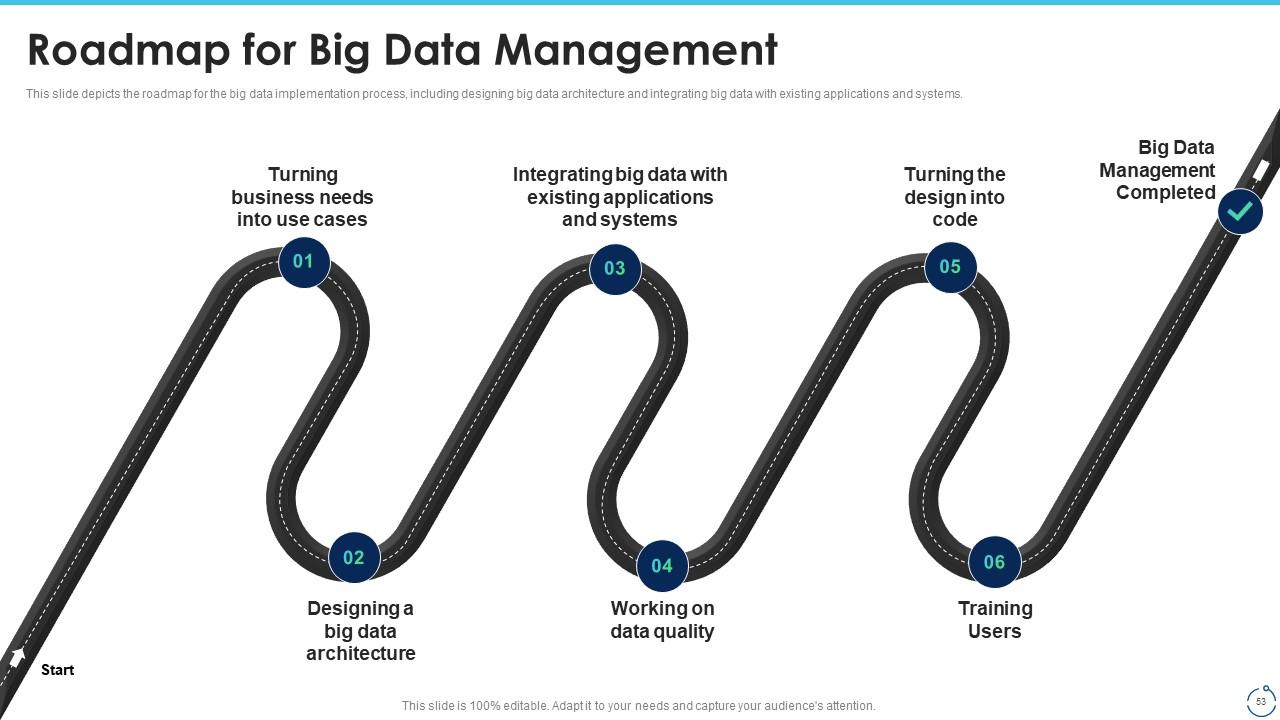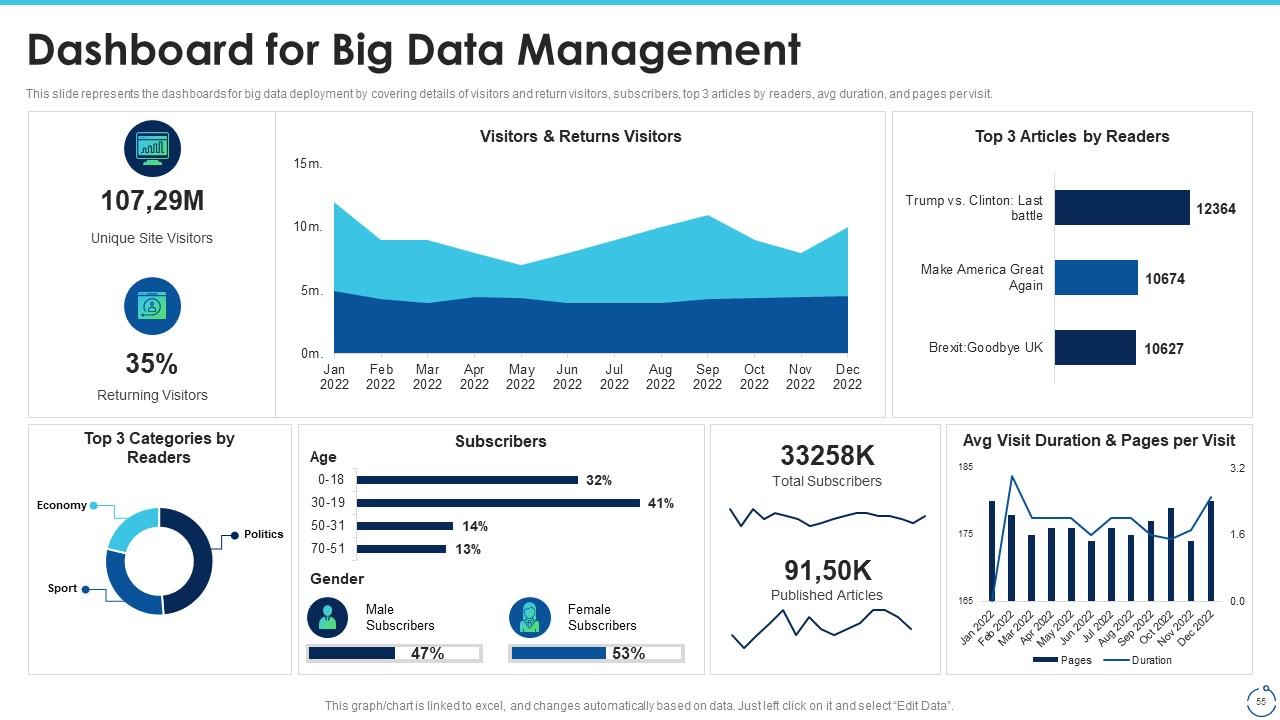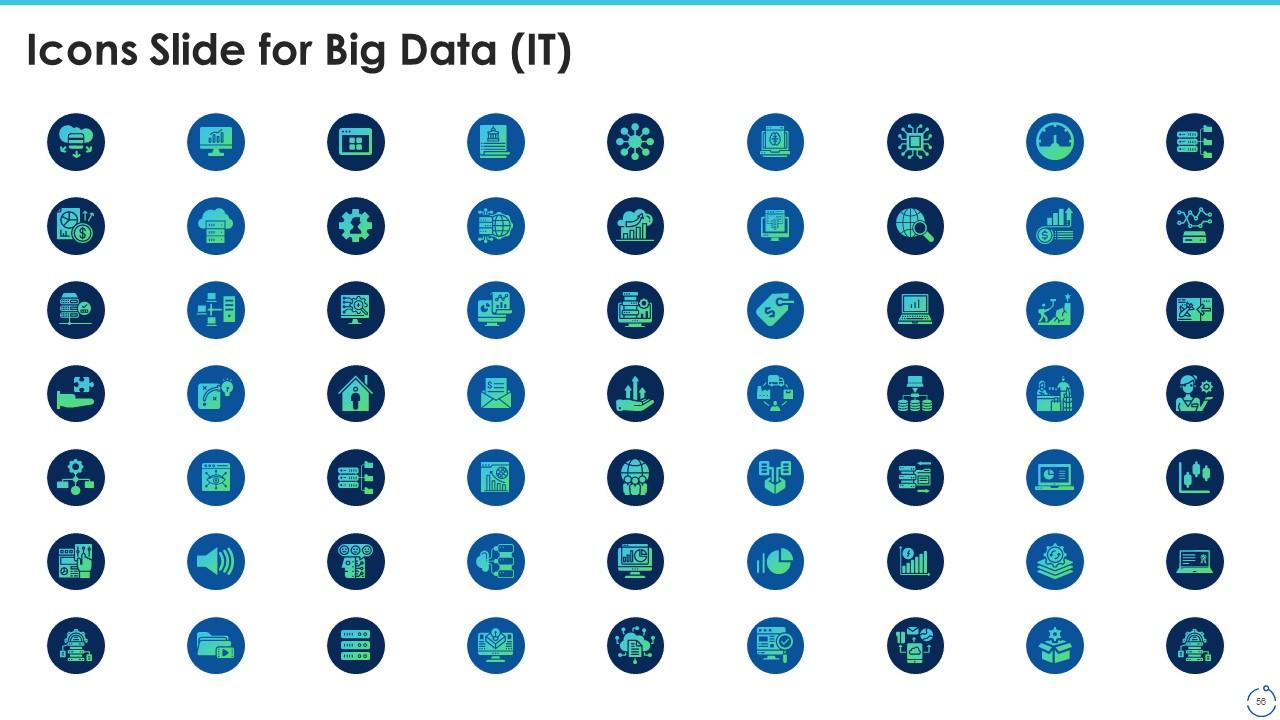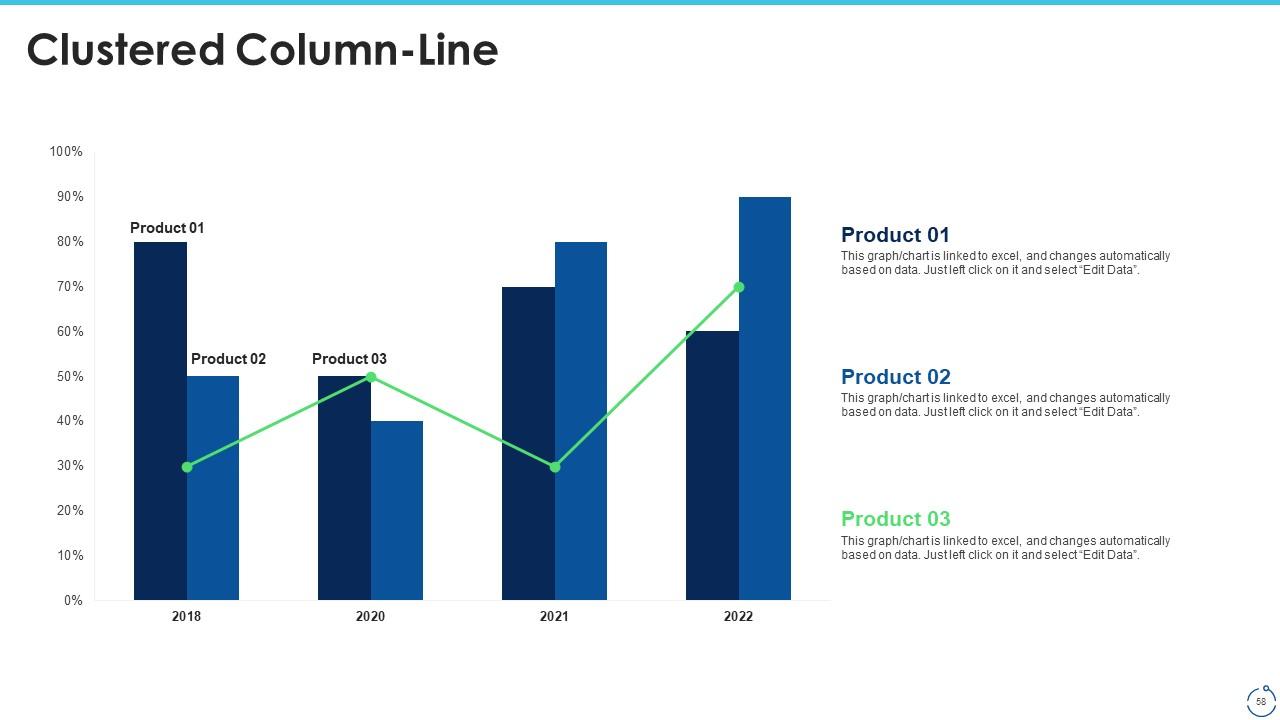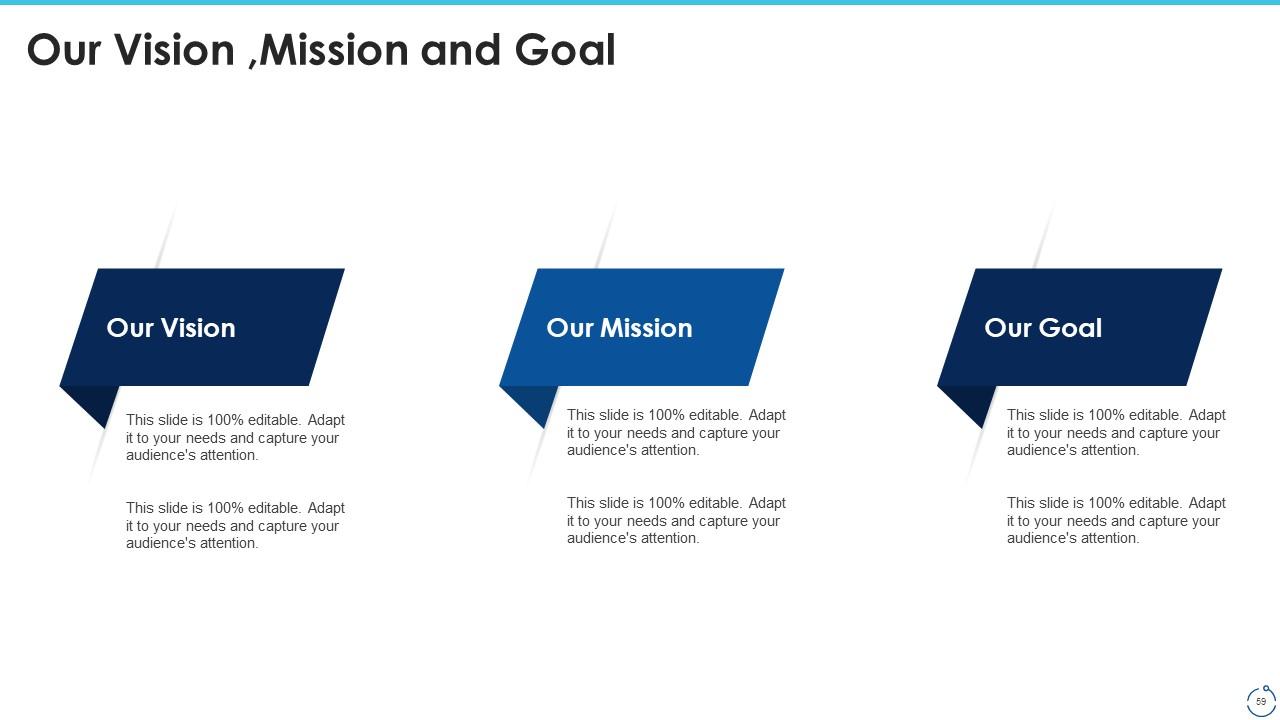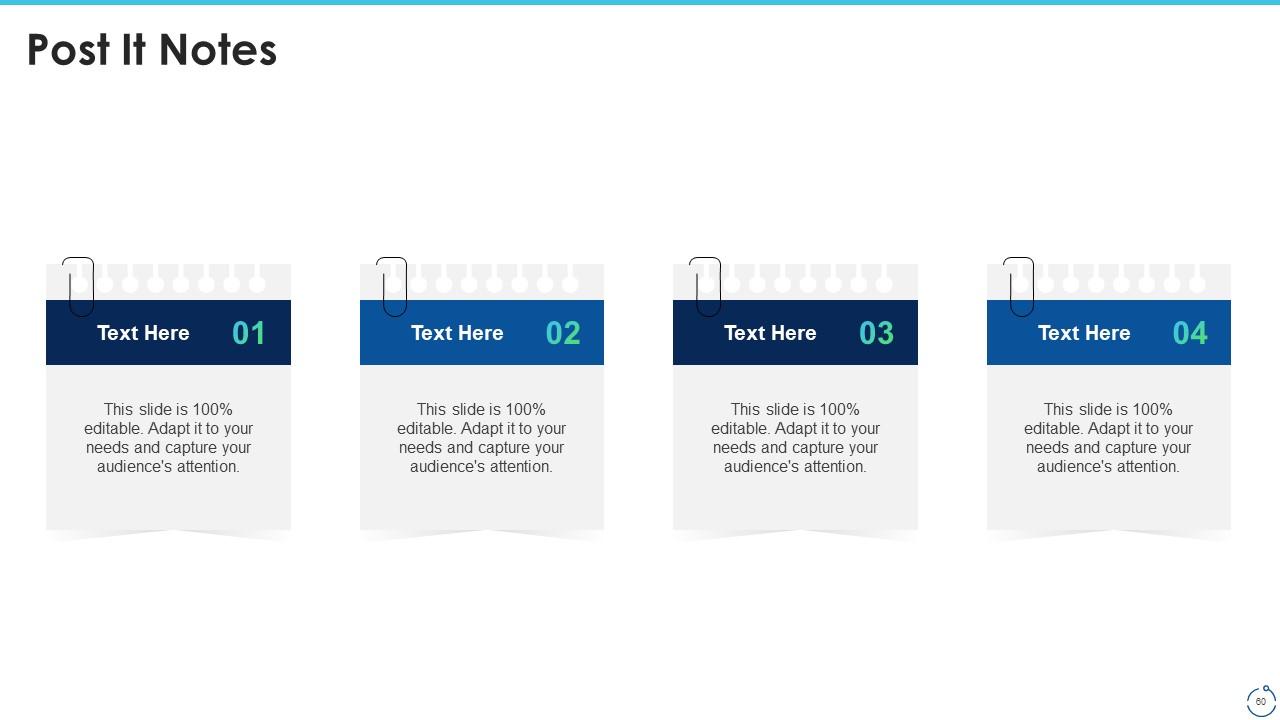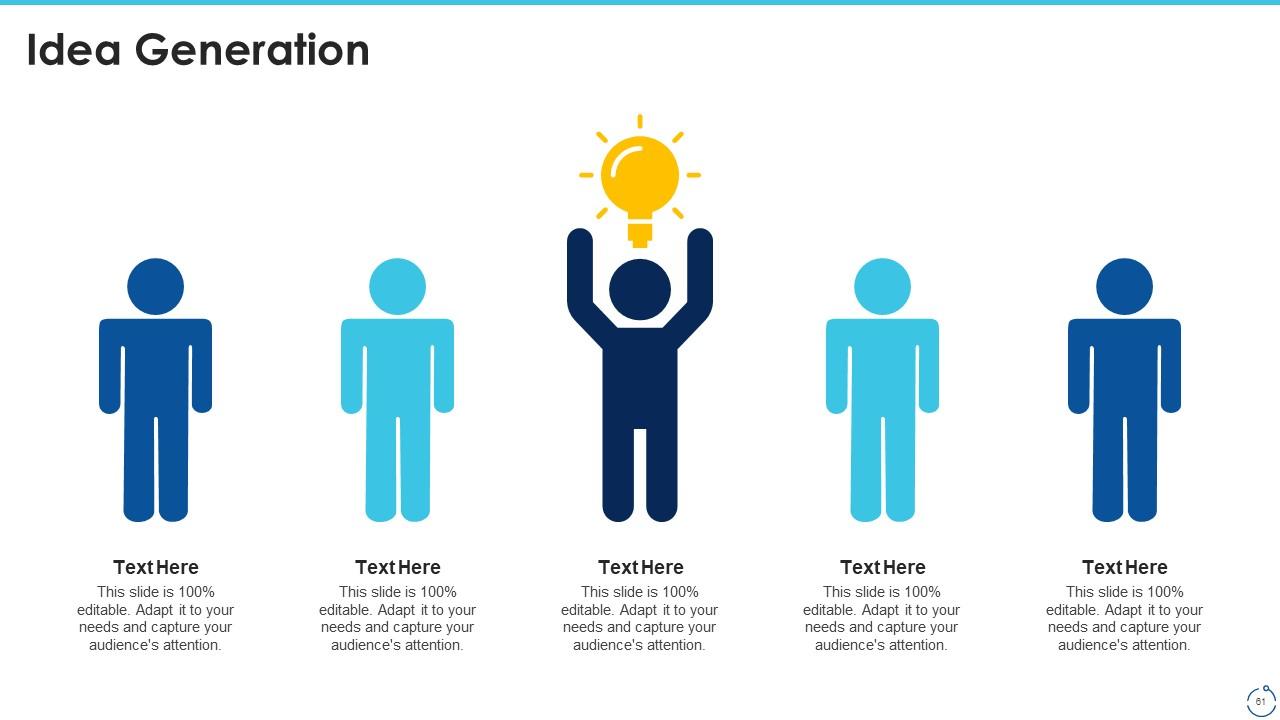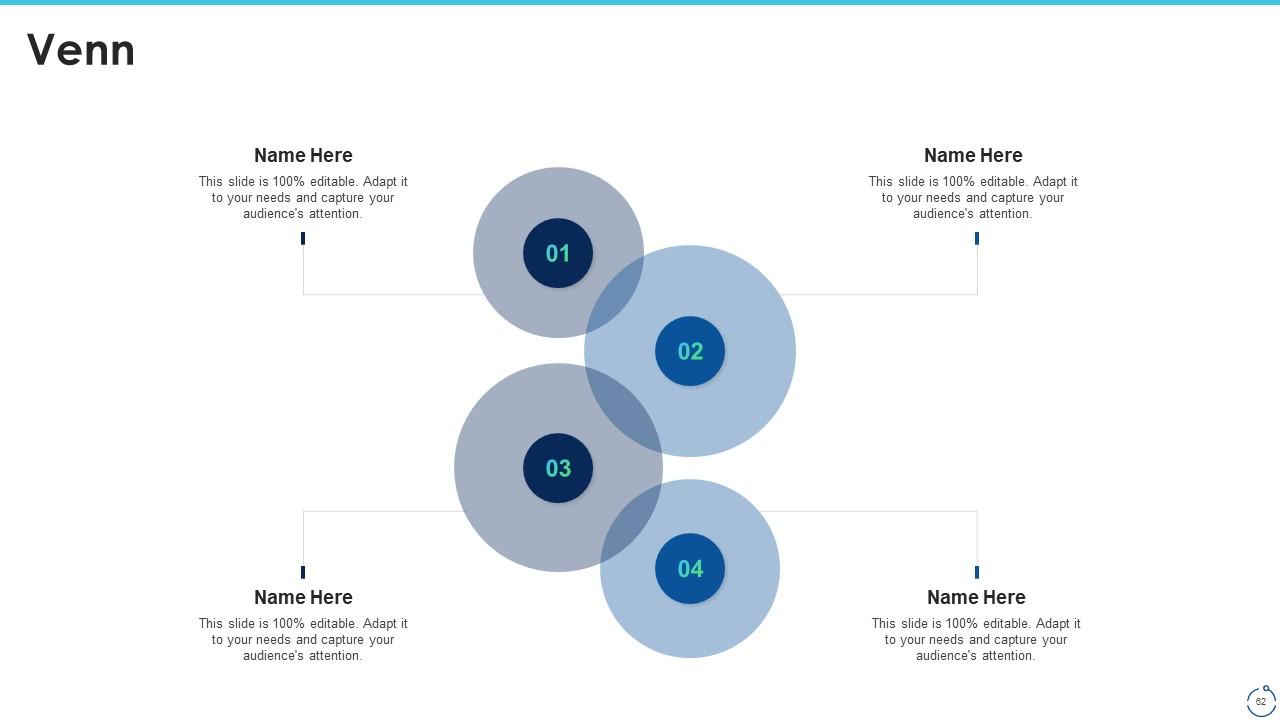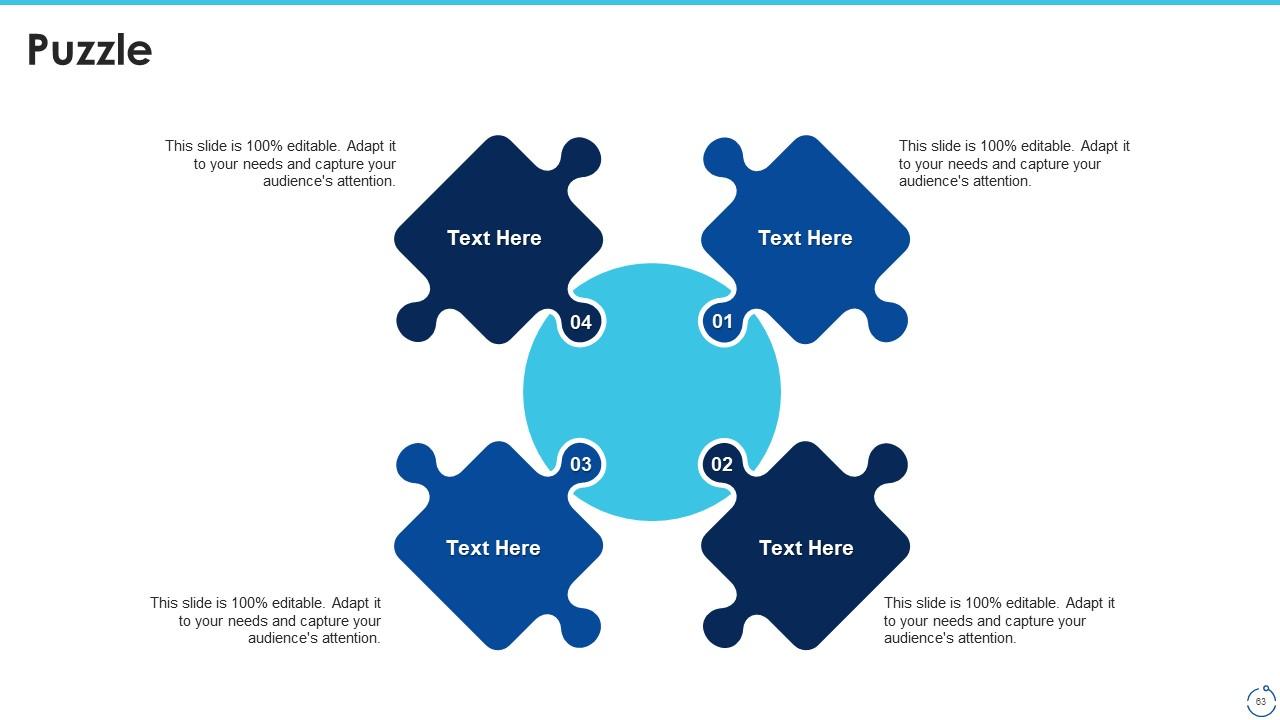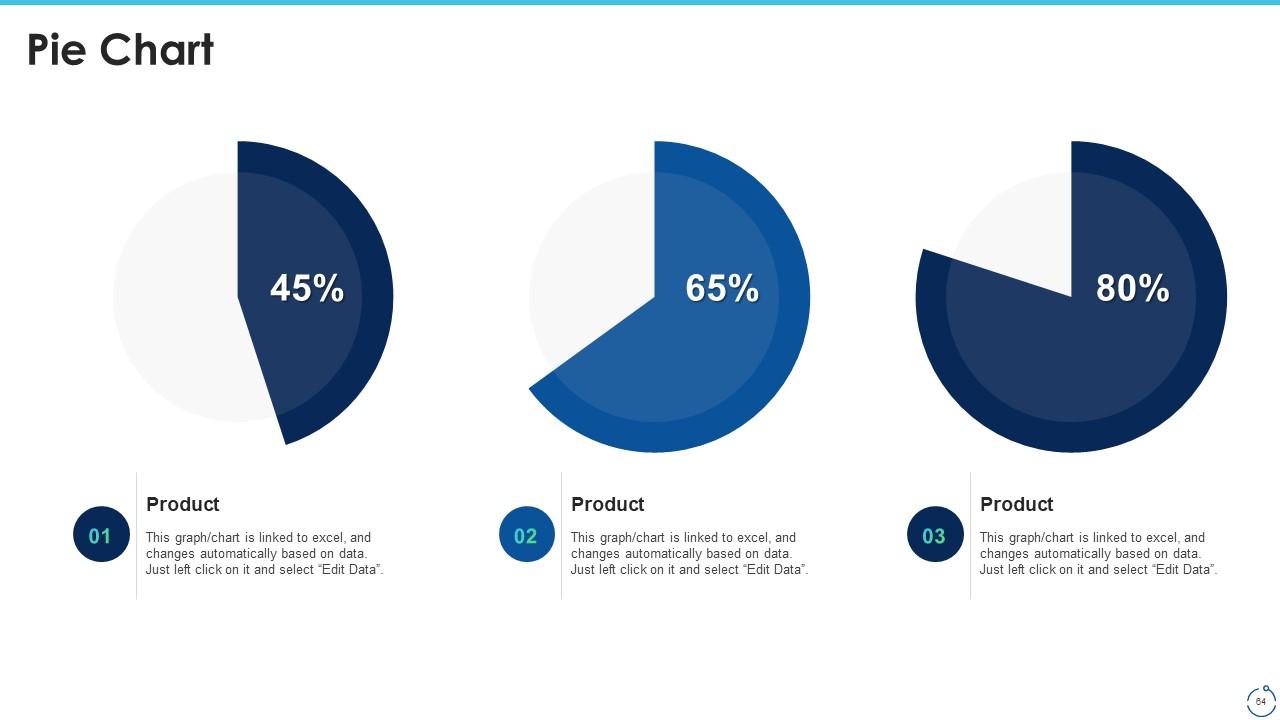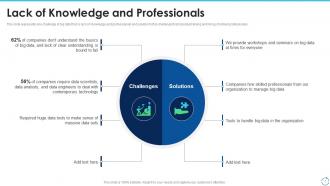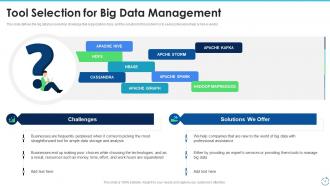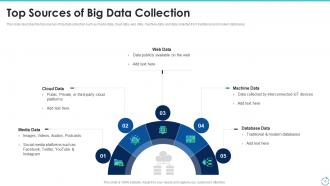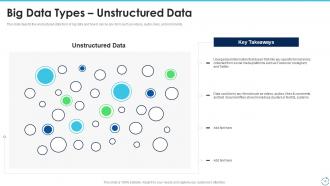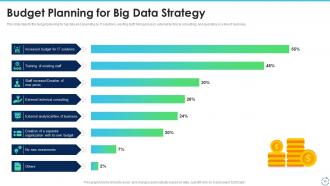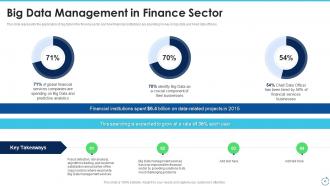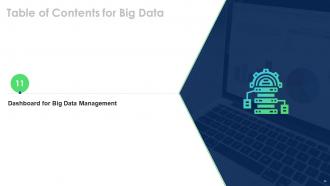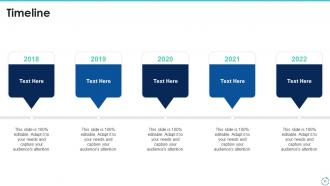Big data it powerpoint presentation slides
Big Data is a massive collection of data that continues to increase dramatically over time. It is a data set that is so vast and complicated that no standard data management technologies can effectively hold or handle it. Here is a competently designed template on Big Data IT that provides details about the problems experienced by organizations to manage big data along with their solutions. It further highlights the top sources of big data, architecture, and workflow of extensive data management. This presentation covers sections for the different types of data, multiple resources of big data, working of big data, technologies, etc. It also comes with a ready-made checklist for big data management. Additionally, this PPT talks about the impacts of extensive data management on business processes and their benefits. Furthermore, this template includes a training program for comprehensive data management, budget planning, and big data applications in different sectors such as healthcare, education, automobile, finance, etc. Also, this PPT provides a 30-60-90 days plan and a roadmap for extensive data management. Lastly, this deck comprises a dashboard for comprehensive data management. Download the template now.
Big Data is a massive collection of data that continues to increase dramatically over time. It is a data set that is so vas..
- Google Slides is a new FREE Presentation software from Google.
- All our content is 100% compatible with Google Slides.
- Just download our designs, and upload them to Google Slides and they will work automatically.
- Amaze your audience with SlideTeam and Google Slides.
-
Want Changes to This PPT Slide? Check out our Presentation Design Services
- WideScreen Aspect ratio is becoming a very popular format. When you download this product, the downloaded ZIP will contain this product in both standard and widescreen format.
-

- Some older products that we have may only be in standard format, but they can easily be converted to widescreen.
- To do this, please open the SlideTeam product in Powerpoint, and go to
- Design ( On the top bar) -> Page Setup -> and select "On-screen Show (16:9)” in the drop down for "Slides Sized for".
- The slide or theme will change to widescreen, and all graphics will adjust automatically. You can similarly convert our content to any other desired screen aspect ratio.
Compatible With Google Slides

Get This In WideScreen
You must be logged in to download this presentation.
PowerPoint presentation slides
Deliver this complete deck to your team members and other collaborators. Encompassed with stylized slides presenting various concepts, this Big Data IT Powerpoint Powerpoint Presentation is the best tool you can utilize. Personalize its content and graphics to make it unique and thought-provoking. All the sixty six slides are editable and modifiable, so feel free to adjust them to your business setting. The font, color, and other components also come in an editable format making this PPT design the best choice for your next presentation. So, download now.
People who downloaded this PowerPoint presentation also viewed the following :
Content of this Powerpoint Presentation
Slide 1: This slide introduces Big Data (IT). State Your Company Name and begin.
Slide 2: This is an Agenda slide. State your agendas here.
Slide 3: This slide shows Table of Content for the presentation.
Slide 4: This slide presents Table of Content highlighting Overview of Big Data Service Company.
Slide 5: This slide shows big data company by covering details of their total associates, entire countries they served in, and total income.
Slide 6: This slide displays Table of Content highlighting Business Solutions We Provide for Big Data Management Problems.
Slide 7: This slide represents lack of knowledge and professionals and solution to this challenge that includes training and hiring of skilled professionals.
Slide 8: This slide shows Tool Selection for Big Data Management.
Slide 9: This slide presents challenge that is paying loads of money on hardware, new hires, software development, and its solution.
Slide 10: This slide depicts another big data challenge that is the complexity of managing data quality.
Slide 11: This slide displays Tricky Process of Converting Big Data into Valuable Insights.
Slide 12: This slide represents securing information in big data challenge of big data and solutions to this challenge.
Slide 13: This slide shows Table of Content highlighting Let’s Discuss Big Data and Its Types.
Slide 14: This slide presents meaning of big data and the complete data handling process.
Slide 15: This slide shows top sources of big data collection such as media data, cloud data, web data, etc.
Slide 16: This slide displays most critical Vs of big data such as volume, variety, velocity, veracity, etc.
Slide 17: This slide represents importance of big data and how collected data will help organizations in cost-saving, time savings, etc.
Slide 18: This slide shows structured data type of big data and how data is kept in specific formats that are handled by machines only.
Slide 19: This slide depicts the unstructured data form of big data and how it can be any form such as videos, audio, likes, and comments.
Slide 20: This slide shows semi-structured data form of big data, and it contains both of the data forms, such as structured and unstructured data.
Slide 21: This slide displays Table of Content highlighting Architecture and Workflow after Big Data Management.
Slide 22: This slide represents Big Data Management Architecture for Business.
Slide 23: This slide describes the layers of big data architecture that include the big data source layer, management & storage layer, etc.
Slide 24: This slide presents the processes of big data architecture, and it covers connecting to data sources, data governance, etc.
Slide 25: This slide shows how big data is stored and processed, along with various data processing technologies for big data.
Slide 26: This slide displays the workflow of big data, including data sources, data management, modeling, etc.
Slide 27: This slide depicts how big data works, and its working falls in three stages: gathering data, storing data, and analyzing big data.
Slide 28: This slide shows Table of Content highlighting Technologies and Strategies We Offer for Big Data Management.
Slide 29: This slide presents big data management technologies, and it includes the Hadoop ecosystem, AI, R Programming, etc.
Slide 30: This slide explains the relationship between artificial intelligence and big data and how it would help detect anomalies, probabilities of future outcomes, etc.
Slide 31: This slide displays comparison between big data and machine learning based on its working, algorithms, data sources, etc.
Slide 32: This slide represents Different Strategies We Use for Big Data Analytics.
Slide 33: This slide shows Table of Content highlighting Impacts and Benefits after Big Data Management.
Slide 34: This slide presents checklist for big data, and it includes guidelines such as alignment of big data with specific business goals.
Slide 35: This slide displays Impact of Big Data Management on Business Processes.
Slide 36: This slide shows Benefits of Big Data Management for Business.
Slide 37: This slide represents Table of Content highlighting Training and Budget for Big Data Management.
Slide 38: This slide shows training program for big data management by covering details of crucial features, skills covered, etc.
Slide 39: This slide presents the budget planning for big data and spending on IT solutions, existing staff, hiring process, etc.
Slide 40: This slide shows Table of Content highlighting Different Industries in Which We Manage Big Data.
Slide 41: This slide displays application of big data in the retail industry and how analytics created with the help of big data.
Slide 42: This slide represents the application of big data in the healthcare department and benefits diagnostics, medicine prevention, etc.
Slide 43: This slide shows Big Data Management in Education Sector.
Slide 44: This slide presents Big Data Management in E-commerce Business.
Slide 45: This slide shows Big Data Management in Media and Entertainment Industry.
Slide 46: This slide displays application of big data in the finance sector and how financial institutions are spending money on big data.
Slide 47: This slide represents uses of big data in the travel industry, and it explains how it is helpful in bookings, pre-arrivals, etc.
Slide 48: This slide shows big data application in telecommunication and helps in product optimization, increased network protection, etc.
Slide 49: This slide presents Big Data Management in Automobile Industry.
Slide 50: This slide shows Table of Content highlighting 30-60-90 Days Plan for Big Data Management.
Slide 51: This slide displays 30-60-90 Days Plan for Big Data Management.
Slide 52: This slide represents Table of Content highlighting Roadmap for Big Data Management.
Slide 53: This slide depicts the roadmap for the big data implementation process, including designing big data architecture and integration.
Slide 54: This slide presents Table of Content highlighting Dashboard for Big Data Management.
Slide 55: This slide shows dashboards for big data deployment by covering details of visitors and return visitors.
Slide 56: This slide displays Icons for Big Data (IT).
Slide 57: This slide is titled as Additional Slides for moving forward.
Slide 58: This slide shows Clustered Column-Line chart with three products comparison.
Slide 59: This is Our Mission slide with related imagery and text.
Slide 60: This slide shows Post It Notes. Post your important notes here.
Slide 61: This is an Idea Generation slide to state a new idea or highlight information, specifications etc.
Slide 62: This slide represents Venn diagram with text boxes.
Slide 63: This slide shows Puzzle with related icons and text.
Slide 64: This slide presents Pie Chart with data in percentage.
Slide 65: This is a Timeline slide. Show data related to time intervals here.
Slide 66: This is a Thank You slide with address, contact numbers and email address.
Big data it powerpoint presentation slides with all 66 slides:
Use our Big Data IT Powerpoint Presentation Slides to effectively help you save your valuable time. They are readymade to fit into any presentation structure.
FAQs
Big Data refers to large, complex data sets that require advanced computing techniques to process and analyze. This data can come from a variety of sources, such as social media, customer transactions, and sensor data. To manage Big Data effectively, businesses can use a combination of technologies, such as data analytics tools, cloud computing, and data management platforms. It is important to have a clear understanding of the goals and objectives of the Big Data project, as well as a plan for data collection, storage, processing, and analysis.
Common challenges in managing Big Data include data quality issues, scalability, security and privacy concerns, and the complexity of data analysis. Solutions to these challenges include investing in data cleansing and validation tools, leveraging cloud-based solutions for scalability, implementing robust security measures, and utilizing machine learning and artificial intelligence to automate data analysis.
The three main types of Big Data are structured, semi-structured, and unstructured data. Structured data refers to data that is organized and stored in a specific format, such as a database. Semi-structured data is data that has some organization but is not fully organized, such as emails or social media posts. Unstructured data is data that has no clear organization, such as images or video. These types of data can be utilized in different industries in various ways, such as predicting consumer behavior, optimizing supply chains, and improving healthcare outcomes.
Technologies and strategies used for Big Data management include data analytics tools, data management platforms, cloud computing, machine learning, and artificial intelligence. These can be implemented in businesses by developing a clear strategy for data collection and analysis, investing in the right technologies, and hiring skilled data professionals to manage the data.
Businesses can plan for and allocate budgets for Big Data management by identifying the goals and objectives of the project, estimating the costs of data collection, processing, and analysis, and evaluating the potential return on investment. The benefits of investing in Big Data management include improved decision-making, better customer insights, and increased operational efficiency. The impacts of Big Data management can also be significant, including the ability to identify new business opportunities, better understand market trends, and improve overall business performance.
-
Unique research projects to present in meeting.
-
Out of the box and creative design.
-
Professional and unique presentations.


